






Published by John Morrow
Edited, Designed, and Co-written by Jon B. Cooke
Proofread by John Morrow & Kevin Sharp
Cover art by Dave Stevens, with color by Homer Reyes
Cover art courtesy of The Rocketeer Trust & Jennifer Stevens Bawcum
Please note that some low-resolution photos in this book were enhanced by image software.
A Corben Special, Fever Dreams TM & © the estate of Richard Corben. Alien Worlds, Pathways to Fantasy, Silverheels, Somerset Holmes, Three Dimensional Alien Worlds, Twisted Tales TM & © BJA Associates. “All My Love, Aliso Road” © Jaime Hernandez. Amazing Heroes, The Comics Journal TM & © Fantagraphics, Inc.
Axel Pressbutton TM & © the respective copyright holder. “The Ballad of Hardcase Bradley” © the respective estates of Stephen Perry & George Evans. Berni Wrightson, Master of the Macabre TM & © the estate of Bernie Wrightson. Blackmark TM & © the estate of Gil Kane. Blade Runner TM & © The Blade Runner Partnership. Bishop, Bold Adventure, Soldiers of Fortune, Time Force TM & © the estate of Bill DuBay. Bombast, Captain Glory, Captain Victory and the Galactic Rangers, Goozlebobber, Jack Kirby’s Secret City Saga, Night Glida/Nightglider, Satan’s Six, Secret City, Silver Star, Thunder Foot TM & © the estate of Jack Kirby. “Bourbon Thret” © Geoff Darrow. Cliff Hanger TM & © Bruce Jones & the estate of Al Williamson. Comic-Con logo, toucan mascot TM & © San Diego Comic Convention. Comics Scene TM & © Creative Group Acquisition Co. Darklon the Mystic TM & © Jim Starlin. Dazzler, Epic Illustrated, Miracleman TM & © Marvel Characters, Inc. Demon Dreams, Mudwog TM & © Arthur Suydam. Detective Flynn TM & © the respective estates of Richard Kyle and D. Bruce Berry. Doc Stearn… Mr. Monster, Ivory, The Wraith TM & © Michael T. Gilbert. Echo of Futurepast, Megalith, Ms. Mystic, The New Heroes TM & © the estate of Neal Adams. Edge of Chaos TM & © the estate of Gray Morrow. Elfquest TM & © Wendy & Richard Pini. Elric TM & © Michael Moorcock. “Encyclopedias” © Mike Baron & Steve Rude. First Folio TM & © The Joe Kubert School of Cartoon and Graphic Art, Inc. Flamingo TM & © the respective copyright holder. Flan TM & © Bruce Jones & Ken Steacy. Freak Show TM & © Bruce Jones & the estate of Bernie Wrightson. Freakwave, Strange Days TM & © Peter Milligan & Brendan McCarthy. “Friend in Need” © Ron Harris. Ghita of Alizarr TM & © the estate of Frank Thorne. Goldyn TM & © Walter Stuart. Groo the Wanderer, Sage TM & © Sergio Aragonés. The Hitchhiker TM & © the respective copyright holder. Last of the Viking Heroes TM & © Mike Thibodeaux. Mike Mahogany TM & © Roger McKenzie & Paul Smith. The Missing Man, The Mocker TM & © the estate of Steve Ditko. Oddball Comics, You-All Gibbon TM & © Scott Shaw! One TM & © Steve and Bill Schanes. Paperbacks, U.S.A. © Piet Schreuders. Planet Comics TM & © The Caplin Company. “Prometheus Primeval” © Tim Conrad. Quark TM & © Mike Baron & Rick Burchett. Quest and Other Tales, Ravens and Rainbows TM & © the estate of Catherine Jeffrey Jones. “The Rescue” © Tim Burgard. The Rocketeer TM & ©The Rocketeer Trust. Rock Warrior TM & © Paul S. Power. Rog 2000 TM & © John L. Byrne. Salimba TM & © Paul Chadwick & the estate of Stephen Perry. Seven Samuroid TM & © Frank Brunner. Sheena, Queen of the Jungle TM & © Galaxy Publishing, Inc. Skateman TM & © John Ballard. Star*Reach TM & © Michael Friedrich. Starslayer TM & © Mike Grell. Starspawn TM & © Michael Netzer. Sun Runners TM & © Roger McKenzie. Tales of Zed TM & © Chris Miller. “The Trains Belong to Us” © Joey Cavalieri & the estate of George Pérez. Vanity TM & © Will Meugniot. V for Vendetta TM & © Alan Moore & the estate of David Lloyd. Warrior magazine TM & © Dez Skinn. World of Wood TM & © the estate of Wallace Wood.
Next page: Left to right, Steve Schanes, David Scroggy, and Bill Schanes, Pacific warehouse in 1983. Photo by Jackie Estrada.
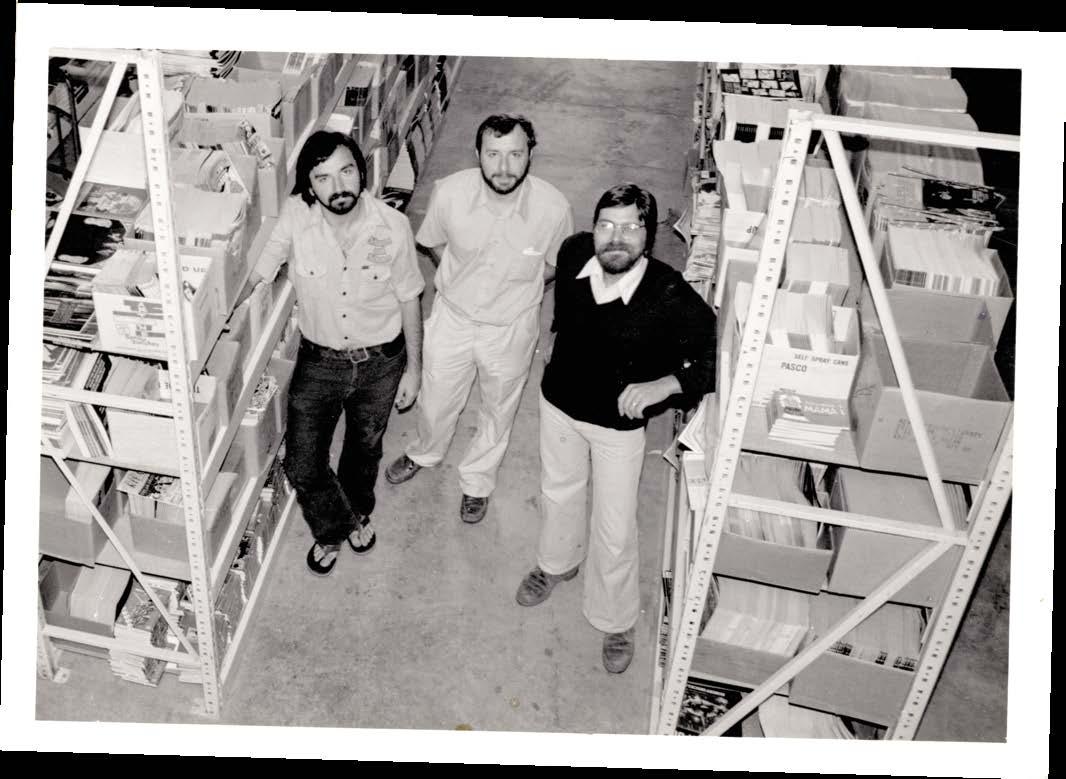
weren’t the first. The New Jersey-born siblings didn’t create the inaugural direct sales distribution company in the comic book industry. Nor were they first to publish independent comics for sale exclusively to the nation’s ever-growing network of shops dedicated to comic books. Certainly, there were others who came before them, but, as Jay Allen Sanford observed, these two had the drive to succeed in the world of funnybooks. “[T]he brothers were industrious,” Sanford wrote, “not to mention ballsy.”1
Launching their endeavors in 1971, when Steven J. was 17 and William D. 14, the first commercial realm in which the San Diego-based brothers invested their energies was to sell back issues of comic books out of their parents’ home, a form of reading material to which the older brother felt indebted. “My high school days were really challenging,”
Steve told Mat Klickstein, “because I was getting C’s, D’s in every class, except for athletics. I did keep comic books in my backpack and teachers were actually very supportive of me reading them during our break time. Specific teachers would take an interest in me because they thought I was intelligent and was just having trouble reading — which is why they were encouraged by my reading comics.”2
Bill, too, suffered the same reading ailment as his older sibling, recalling to Klickstein, “In 1971, my brother and I were riding bicycles to a swap meet. And when we got there, we were walking up and down the rows of just junk and stuff that people had all laid on the asphalt. This lady had an old wagon just chockful of comic books. I have dyslexia, but I had actually never seen a comic book before. So, I sat down and did my best to read a couple of them in front of her stand. I really enjoyed them. I read all of them completely through and said to my brother, ‘Let’s buy these.’ We asked how much she wanted for all the books she had. And she said she had about 900 comics, mostly Marvels and DCs from the ’60s and early ’70s, a few from the ’50s and from the ’40s. Fifty dollars for the whole 900 comics. Well, as two teenagers, we didn’t have $50. So, we asked her to hold onto them for about an hour. ‘Would
you give us enough time to ride our bicycles back to our parents’ house?’ We asked our parents for $50 — and, of course, a ride down with the car to pick all these comics up. Luckily, my mother saw my enthusiasm for reading, which was not one of my top priorities back then, due in large part to my dyslexia. ‘Gee, if he’s going to be excited about reading something, at least let him read some comic books.’ She drove us down, gave us the 50 bucks, and we bought the comics, loaded them all up in her station wagon, and brought them back to our house.”3
In an essay for The Jack Kirby Collector, Steve recalled the exact same number of comics purchased as well as the identical price, though some other details differed. “I was age 17, walking through a flea market looking
Born: Apr. 1954
It goes without saying that Steve and his brother Bill were the founders of Pacific Comics, an outfit whose origin dates back to 1971, when Steve was 17. After Pacific closed, he immediately began Blackthorne Comics, an imprint lasting until 1990. Today he runs Schanes Products and Services, a pop culture consulting firm.
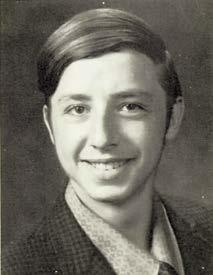
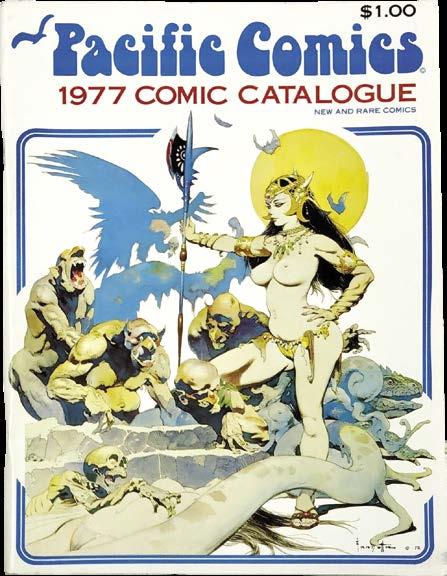
Born: Sept. 1958
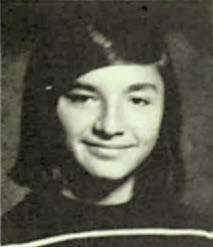
With brother Steve, Bill is the principal partner in Pacific, and he went on to work for many years with Diamond Comic Distributors, said to be essentially second-in-command behind owner Steve Geppi. Bill retired from Diamond in 2013 and is today Oni Press’ publishing consultant.
for unique items,” he explained. “I came upon a man who had several boxes of comic books for sale. I always liked comic books and learned to read with the help of comics. (I was born with a severe case of dyslexia and could not read well because the words would be configured in my mind differently than they were actually printed. Comic books enabled me to see pictures along with words; the words now made sense.) I bought the collection of 900 comics for $50. I was a big fan of DC Comics and could not relate to Marvels. I gave the Marvels to my brother Bill, age 14. Immediately we decided to become comic book dealers.”4
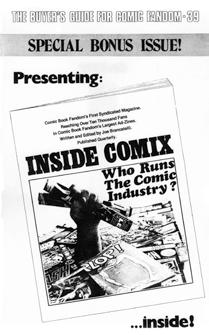
Bill remembered their transition into becoming entrepreneurs as happening literally while the comics were being hauled out of the family station wagon. “As we were unloading them,” he said to Klickstein, “my next door neighbor came over and was really excited. He saw we had a bunch of comics, and he was our age, and he said, ‘Hey!
Here’s Fantastic Four #2! I’ll give you $38 for it.’ Well, we didn’t know comic books had issue numbers or creators or anything. All we wanted to do was read the 900 comics. And we were thinking, ‘This guy wants to pay $38 for one comic after we spent only $50 on 900 of them?!’ We said to him, ‘Sure! You can take Fantastic Four #2 for $38.’ And that was our little introductory lesson to comics. We ended up with about 30 people over at our house — our parents’ house — rummaging through these boxes, buying stuff. We made hundreds of dollars on that very first weekend selling comics. The only rule, of course, was my brother and I had to read them before we could sell them. That was the only rule of engagement. We had no idea there’s a business involved. We were just enjoying the idea of having friends over, all kindred spirits, who loved comics, too. That little bit of interest there that weekend really initiated our creating ‘Pacific Comics.’”5
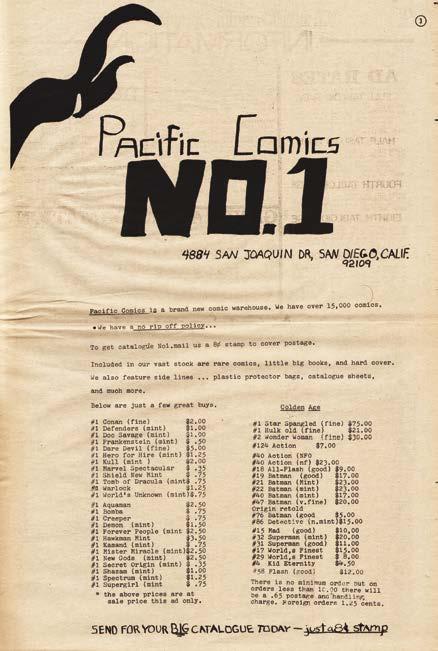
Steve described how they kept the fledgling business growing: by going on the prowl to refresh their inventory. “Every day after school,” he wrote in the Kirby Collector, “I would ride my bike around the small town of Pacific Beach looking for old comics at used book stores. The collection grew rapidly. The next year we issued our first mail order catalogue, placed our first ad in The Buyer’s Guide For Comic Fandom [#39, July 1, 1973], and attended our first San Diego Comic Convention. (I met Jack Kirby at the 1972 con.) The response to that first catalogue was overwhelming. People we didn’t know were sending us thousands of dollars. The collection grew too big for our parents’ home; both bedrooms were full, floor to ceiling.”6
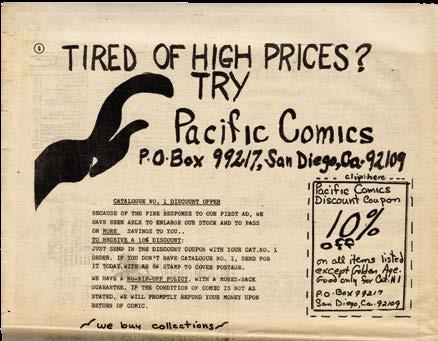
The siblings decided to christen the new enterprise after their own California neighborhood (to where, in the ’60s, they had moved from New Jersey), as Bill explained the name to Klickstein. It was, he said, “A combination of ‘Pacific Beach’ in San Diego and ‘comic books.’”7
1973].
The first TBG Pacific Comics ad, which featured a suburban San Diego address of San Joaquin Drive, was a full-pager that boasted the company had a brand-new warehouse and over 15,000 comics, and it also declared, “We have a no rip-off policy.”8 Listed items for sale included Conan the Barbarian #1, in fine condition, for $2, and the Golden Age Star Spangled Comics #1 for $75, in fine condition.
Indeed, the initial advertisement proved a success for the new enterprise as, five issues later, in TBG #44 [Sept. 15, 1973], the boys purchased a half-page (now listing a post office box as address), which had a discount coupon for 10% off “on all items except Golden Age.”9 The first incarnation of Pacific Comics was off to a profitable start. However effective they were in generating sales, those early ads put together by the Schanes brothers were pretty crude efforts, with hand-drawn headlines and a curious logo design, with an illustration that vaguely looked either like a seagull or duck’s head, depending on one’s perspective. That same branding image was used on signage when the Schaneses established their first shop.
About their brick-&-mortar endeavor, Steve told Comics
Interview #55, “We opened a small retail store in Pacific Beach, on Cass Street, basically to give my mother some space in her house, which had been lost to the comic books, which, by that time, had monopolized most of the house. For the sake of getting them out of the house, we started the store, and we started [it] on a $400 budget… Myself, Bill, and my mother worked at the store.”10
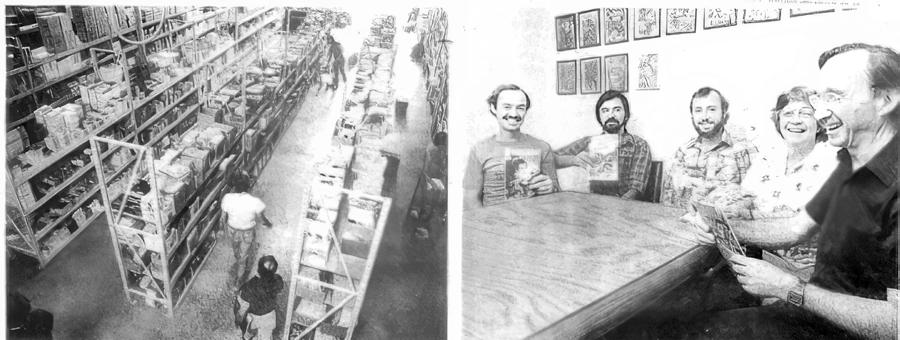
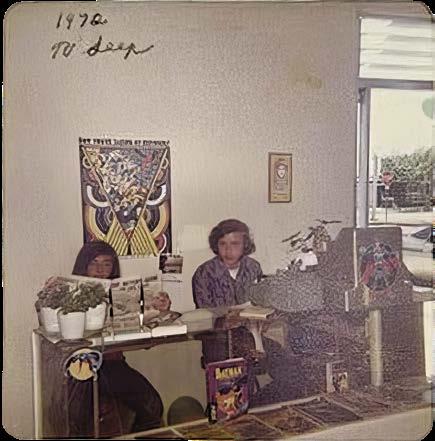
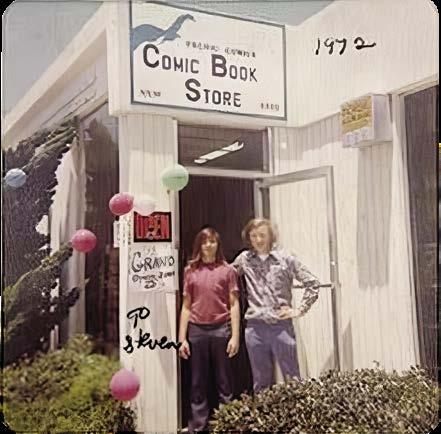
Their retail and mail order enterprises were making copious amounts of money, a bounty which had its own unique, if temporary, drawback for the young partners. Bill wrote in a Facebook post, “We needed to open our first business bank account at Crocker National Bank, which was located in San Diego, California. I was told I was too young, and I must come with a parent to co-sign, to open up a bank account. I went back home and told my parents, who didn’t understand and were a little upset. The next day, my mother came to the bank with me and the teller explained about the co-sign to my mother.
“My mother said that I wanted my own account under the ‘Pacific Comics’ name and I plunked down several

Born: Dec. 1951 David would have a long career in comics after his Pacific stint as editorial director, prominently as head of new product development at Dark Horse until retiring in 2017. Today he lives with wife Rosemary in Scotland. He went to high school with rock star Chrissie Hynde, Craig Yoe, and Paul Mavrides.
thousand dollars in currency and coins, from all the Pacific Comics mail-order catalogue orders (we hadn’t gotten any orders for actual products yet, as mail wasn’t very fast at that time). The teller had the bank manager come over and, after I explained why I wanted my own account, he allowed me to have one, without having my mother as a co-signer.”11
get out of the house, make it an official business, and find a location. Which is what we did: a small retail store in San Diego, of course in Pacific Beach.”13
Below: Though they missed the very first San Diego ComicCon, the Schanes brothers became perennial exhibitors during the lifespan of Pacific Comics and they were also active participants in various capacities at the annual event. The Buyer’s Guide publisher Alan Light took this snapshot of Steve [left] talking with a con attendee at the 1982 show.
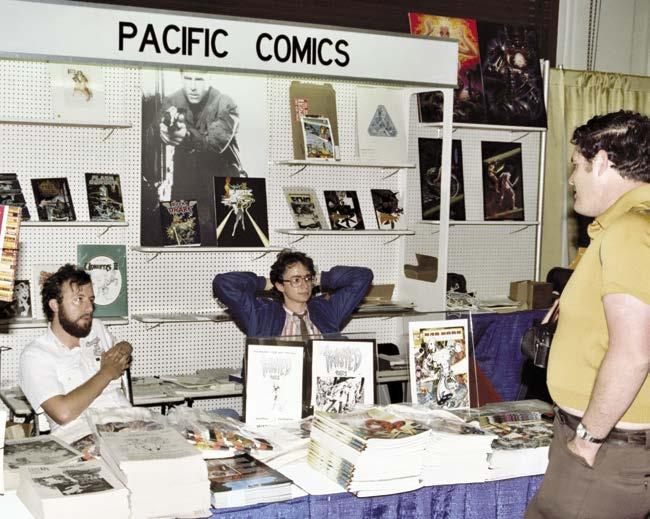
Bill added, “As a side note, when you opened a new account at Crocker National Bank, you got a teddy bear as a welcome gift. I told the manager that, if I owned the bank and I was giving a gift to new customers opening an account, I would give them a ‘Crocker Spaniel,’ a play off of the name of the bank versus a bear — which was cute, but once you brought it home, you wouldn’t remember where you got it from. A few months later, the bank started handing out ‘Crocker Spaniel’ plush dogs to new accounts.”12
About his memory of launching their first retail operation, Bill said to Klickstein, “Within a couple of years, we were doing a couple hundred thousand dollars out of my parents’ house, and were having almost like mini-conventions on weekends — tons and tons of fans coming over to buy, sell, and trade. This encouraged us to
He continued, “It was about a two-mile bike ride — our mode of transportation in those days — from our parents’ house. The store was about 1,000 square feet and our hours were basically after we got out of school. Noon-to-six on weekdays and nine-to-five or nine-to-six on weekends. I had gotten permission from my high school to attend early classes so I could do all of this. I’d go to school on my bicycle, be there at 7:00 in the morning, then bike 30 minutes to the store to open at noon. And I did that for several years.
“So, Pacific Comics started off as a house business, thanks to a swap meet, transitioned to a mail order business, and then our first store in Pacific Beach. Pretty crazy. Through the store, we met Shel Dorf. As a young teenager, he seemed like such an older guy. It was like, ‘Why is he involved in reading comic books?’ But then I quickly realized that comic books bridge all gaps. They bridge age groups. Really, if you just enjoy entertainment, enjoy escapism, enjoy the idea of reading books, it could be anybody out there. And Shel was just one of those guys. He treated me really well as a kid.”14
In 1975, newly arrived to San Diego from his native Ohio, 23-year-old David Scroggy was helped by San Diego Comic-Con co-founder Shel Dorf, resulting in David volunteering for the con and Shel arranging with TBG publisher Alan Light for David to write a regular column for the bi-weekly. In a tribute to Dorf (who died in 2009), David said, “Comic-Con and the column got me a job at Pacific Comics.”15
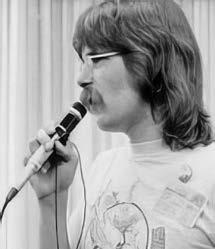
David explained to the author, “Initially, I managed the Cass Street location of Pacific Comics. I opened and closed the store, scheduled our staff of part-time help, worked the counter, sorted the back-issue stock, and things like that. Bill and Steve handled the accounting, purchasing, dealings with vendors and the landlord, and the ‘big picture’ financial planning.”16
Included in that “big picture” was a significant move for Pacific, as David told the author. “Not long after I joined the company, the Schanes brothers, who had been challenged in obtaining a reliable supply of new comics, became an early account of direct-sales comic market pioneer Phil Seuling. Prior to that, their main
source of supply was local magazine distributor San Diego Periodicals. They were an example of what was called the ‘I.D.’ [independent distributor] distribution system, which was an unfriendly, wasteful, and corrupt network of magazine distributors. They were unfriendly to comic books in general, and, as Pacific’s needs grew, increasingly, to the Schanes brothers.”17
David continued, “It wasn’t long before the Schanes
brothers realized that the non-returnable discount offered by Seuling’s Sea Gate firm, while a big improvement over the local I.D. distributor, was also unfair. Seuling had been granted national exclusivity as distributor to the fledgling comics specialty retailer market. ‘Why,’ the Schaneses asked, ‘should one person be granted our entire market?’ Pretty much simultaneously, Pacific Comics and a company called New Media Irjax challenged the legality of the unwillingness of Marvel and DC to set terms and open their wholesale sales to other qualified entities. This caused the corporate higher-ups at Marvel and DC to look more closely at the comics specialty channel, which, up until then, had escaped their notice. They quickly saw that Seuling’s sweetheart deal was rife with potential liabilities for their comics imprints. Non-returnable wholesale terms were set, and Pacific, along with a number of other companies, were able to purchase in bulk directly from the publishers and become distributors themselves.”18 Pacific seized this opportunity.
During all this, Steve and Bill recruited local San Diego cartoonist Scott Shaw! to render a mascot for the company, resulting in “Captain Terrific Pacific,” a cloaked super-hero who appeared in Pacific Comics ads and, according to the San Diego Reader, “on bus benches all over San Diego in the mid-1970s.”18
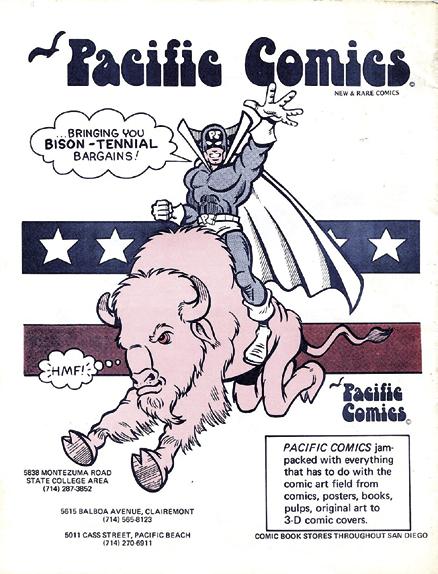
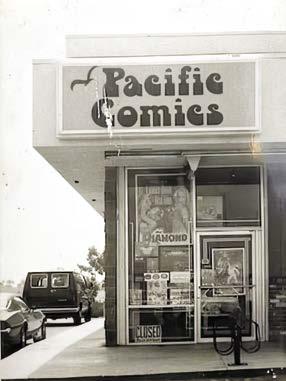
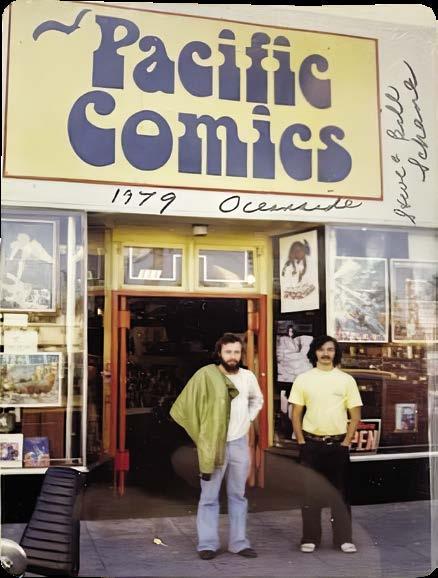
By decade’s end, the Schanes brothers had expanded their retail empire and opened three other shops. The second was located in San Diego’s Clairemont neighborhood, and the third was established near the San Diego State University campus. The fourth was located in Oceanside, about 35 miles north of San Diego.
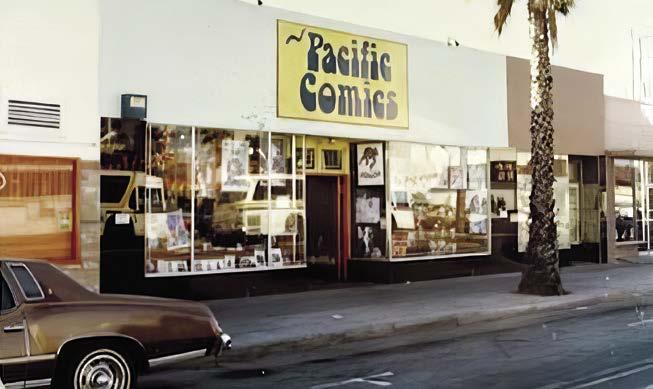
This page: Just a few of the Pacific Comics mascot Captain Terrific Pacific cartoons rendered by Scott Shaw!, whose association with the Schanes brothers ultimately resulted in the funny animals anthology, Wild Animals. Below is an ad targeting area college students and, at bottom, the ad seen by a zillion Marvel Comics readers, this repro’d from Star Wars #3 [Sept. 1977].
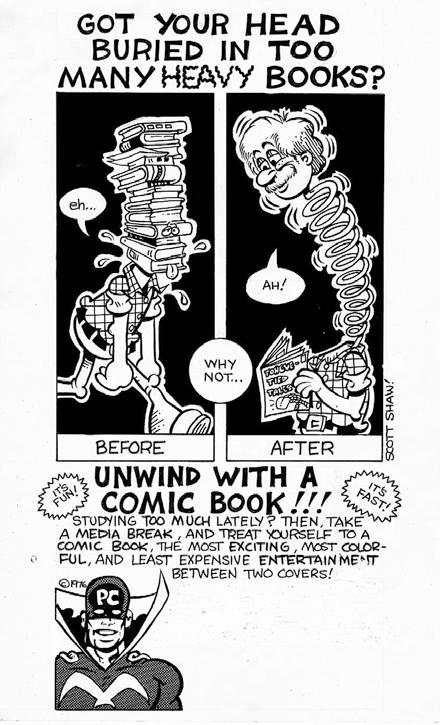
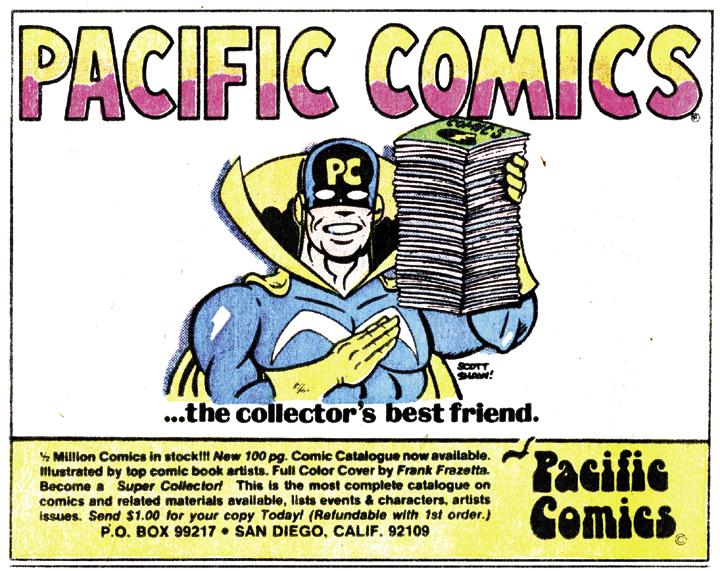
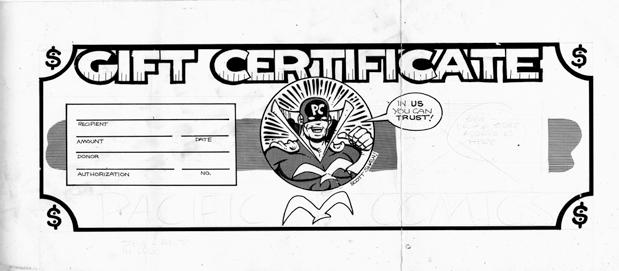

Born: Sept. 1958
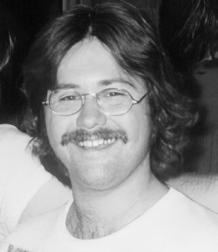
Scott has worked on underground comix, funny animal comics, Saturday morning animated shows, licensing art, and toiled for advertising agencies. A mainstay at the San Diego ComicCon, you can always find the talented cartoonist exhibiting next to longtime friend Sergio Aragonés in Artists Alley!
Above: Scott
for the camera in a pic taken at the 1976 San Diego Comic-Con.
Next page:
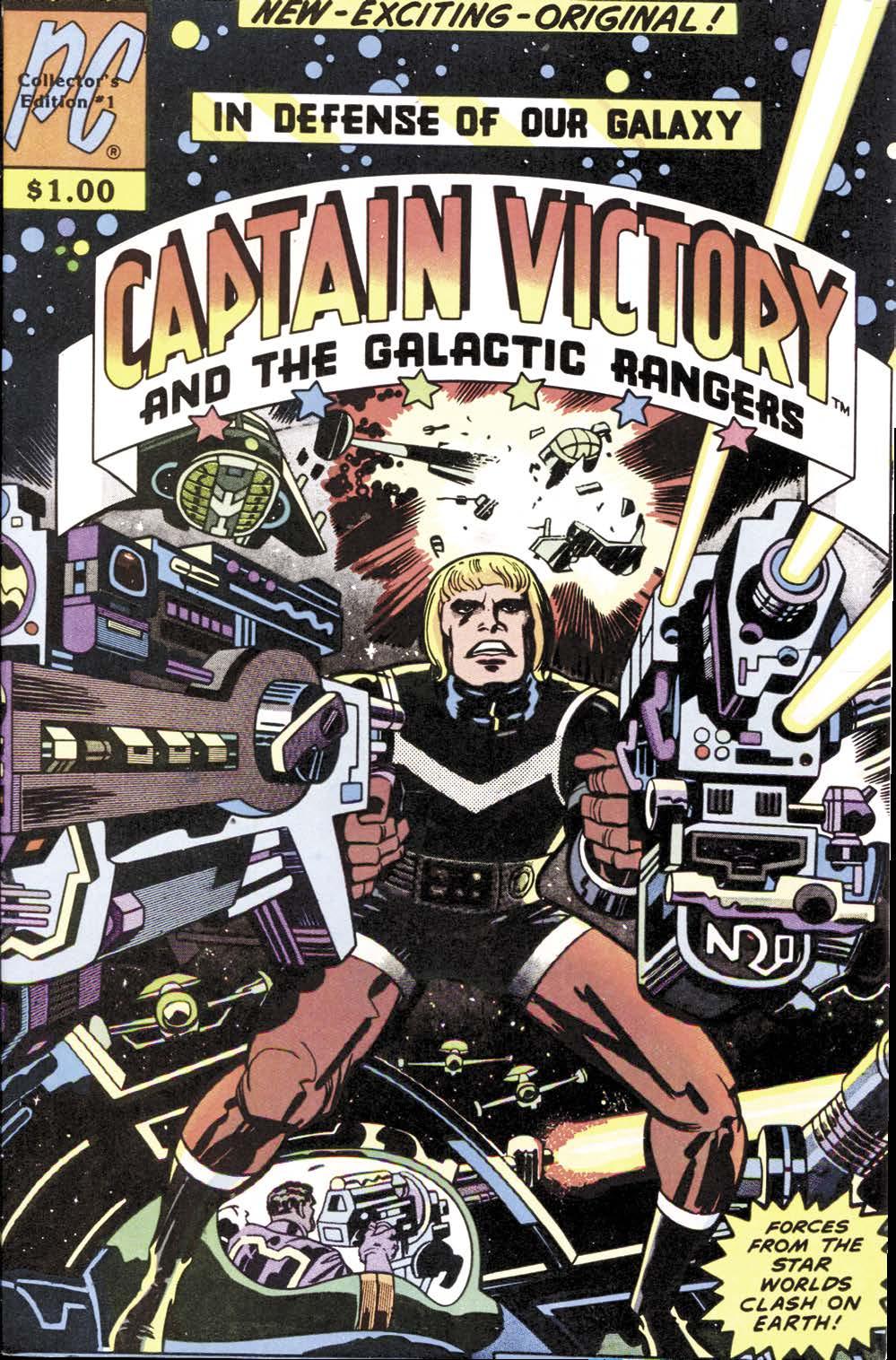
Steve Schanes told Jay Allen Sanford he knew who he wanted to launch a comics line. The Pacific co-owner hoped for comic book royalty. “I figured,” he said, “if you want to get people’s attention with a new comic book, who better to do it with than the King of Comics, Jack Kirby! We were already friends with Jack. We used to send him free copies of comics he’d drawn for other publishers because they never sent him any! So I just went ahead and called him on the phone, and he turned out to be a nice guy, completely accessible… we negotiated a whole detailed publishing deal between the two of us. No middlemen.”1
In an essay for The Jack Kirby Collector, Steve recalled starting their new business. “Bill and I decided we would become a comic book publisher. There were no books on this subject, and the major companies weren’t about to give us any free advice. We needed an approach that was unique and fair. After discussions with comic book artists and writers, we became aware that these creative people did not own or control the concepts they created. Opportunity knocked: we would offer creator rights and a progressive royalty program… The talent was very thrilled by this radical new approach, but… hesitant because they could be blacklisted if they bucked the established system.”2
It was 1981, Bill remembered, when they started to formulate a plan. “As we began to figure out how to approach this,” he told the author, “we looked at what DC Comics and Marvel Comics were publishing at the time, plus we also learned what both companies were paying the creators/talent on both a per-page rate, as well as who owned what (company-owned intellectual properties versus creator-owned properties).” To that end, he added, “We engaged Mike Friedrich early on into this process as a consultant to help us craft a creator-friendly agreement.”3
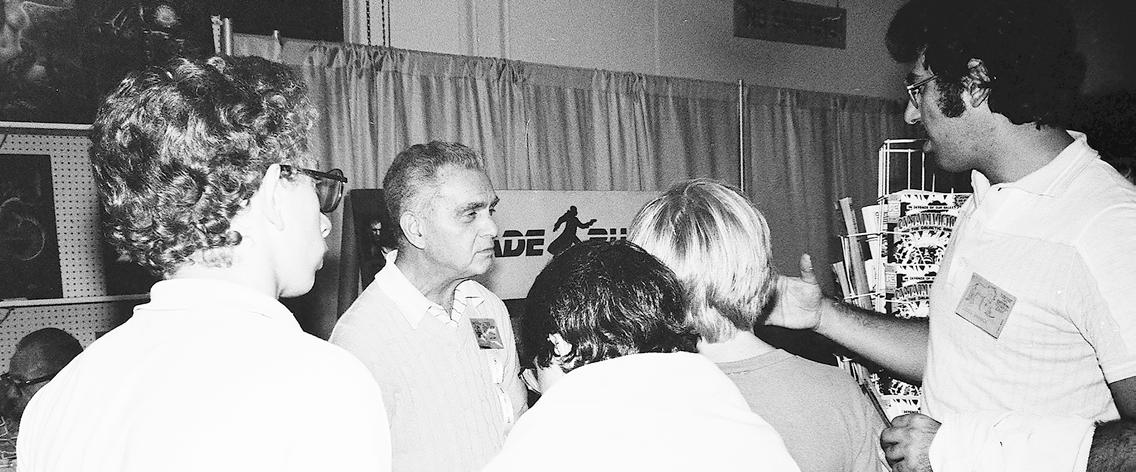
Back in the ’70s, Mike Friedrich (who started off as a comics writer for the “Big Two”) was publisher of Star*Reach and its sister magazines, comics that were dubbed as neither underground nor mainstream, but instead called “ground-level.” Of his company, Gerard Jones and Will Jacobs explained, “Star*Reach Productions, with its creator-owned, Comics Code-free, personal artistic efforts, was for him what Wally Wood had once called ‘the real stuff.’ ‘I think that if people are actually involved from the top to the bottom in a common endeavor, really involved,’ Friedrich said, ‘everybody is going to be more productive… If the writers and artists have a piece of it, they’re going to be more involved and going to do a little bit more than if they don’t.’”4 (By 1979, Friedrich had shut down Star*Reach as a publishing company, but as he remained acutely aware, comics creators needed to take charge of their own creations and keep rapacious
Previous
page: Captain Victory and the Galactic Rangers #1 [Nov. 1981]. Below: Jack Kirby at the Pacific Comics booth during the 1982 San Diego Comic-Con. Note the CV comics in the spinner rack. Photo by Jackie Estrada.publishers at bay as best as possible. To that end, he established a comic creator agency in 1981, under the same Star*Reach name.)
David Scroggy told Mat Klickstein, “My bosses Bill and Steve Schanes had come to an epiphany early on, realizing that, ‘Hey, we could publish better comics than the ones we’re distributing and selling!’ In those days, it was a very unfair deal (and, in many ways, still is today) for creators. Very few of them got ownership of their own material. Nothing in the way of royalties; they just simply got a flat fee: whether their books sold a hundred thousand or a million copies, they were paid the same. Creators had no ownership of the intellectual property of their comics.”
David continued, “So, the Schanes brothers had a very simple but brilliant idea, which was to make a better deal for creators. They offered them ownership of their intellectual property and they offered to pay on a royalty basis. And this, in turn, attracted some of the biggest names ever in the industry. Our first comics were by Jack Kirby. Captain Victory.”5
But the King of Comics was actually not the first creator approached to kick off Pacific Comics. Bill told Ed Catto,
“Most people don’t know this next tidbit, but we intended on our first major release to be a project Gil Kane was working on at the time – Blackmark.”6 Bill expanded on that fact in a Facebook post: “We had originally reached out to Gil Kane to launch our Pacific Comics line of full-color comic books. Gil had a very interesting project called Blackmark, which had originally been published as a paperback book in 1971, by Bantam Books. We sold these in our chain of retail comic book stores back in the day.
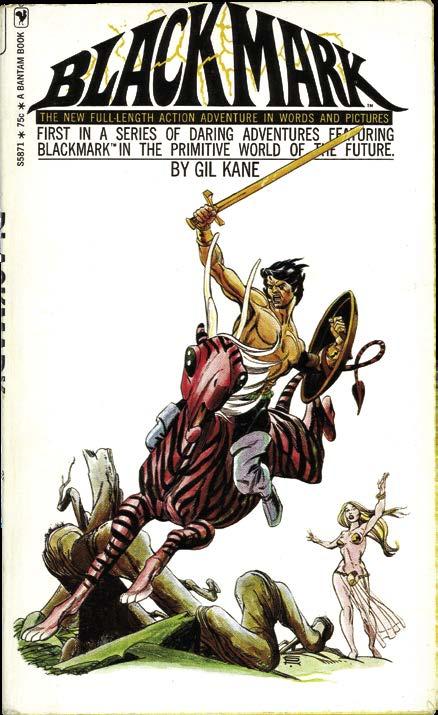
“Gil very much liked our creator-friendly contract, but Gil was really old school, and he wanted to have Blackmark [as a comic book] on newsstands nationwide. Gil was quite stubborn and was challenging to have a conversation with. We didn’t believe in the newsstand channel as a viable distribution model, as the sell through percentages often were as low as 20%, and we felt the whole old school fully-returnable system was so out of date and fundamentally flawed. Also, when we were going to launch our line of full-color comic books, we wouldn’t have any advertising revenue, just sales from the actual comic books.” Bill added, “We couldn’t come to terms with Gil, but instead lead with the king, Jack Kirby! Can’t get any better than that. (Side note: I seem to recall Gil wanted Blackmark published as a black-&-white comic book versus full-color.)”7
The latter ’70s was a period in flux for Jack Kirby. He had bounced between DC Comics and Marvel earlier in the decade, when he encountered disrespect and his comic books were disparaged by some in editorial positions. By 1979, he had left mainstream comics behind and found work in animation, drew a syndicated newspaper strip, and worked on visual concepts for a science-fiction movie (later used in a daring — and successful — scheme to covertly rescue diplomats from Iran, as depicted in the film, Argo).
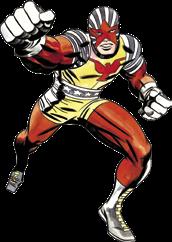
around wide-eyed and speechless as I checked out the seemingly endless, depth-less shelves overflowing with new comics, graphic novels, magazines, toys, Japanese models, and hundreds of other items, including years’ worth of back issues of Cerebus, ZAP Comix, and The Fabulous Furry Freak Brothers. Pacific-published comics in sealed boxes[that] were stacked up by the pallet-load and being shuffled around by guys on forklifts. About a half-dozen employees packed customer orders in various departments spread out over two floor levels in the warehouse.”
While Pacific Comics did launch a brand-new comic book publishing house, it retained the distribution branch of the outfit — the parent company being dubbed Blue Dolphin Enterprises — which had grown into a powerhouse by the early 1980s. “When Marvel opened itself up to working with new distributors, Pacific signed up,” wrote Dan Gearino, “and became the regional player in Southern California.”19
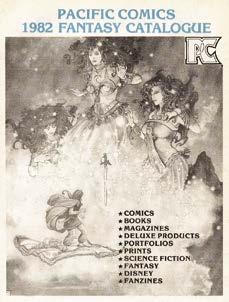
The Schaneses began eying the national scene and made a move to expand beyond their 17,000-squarefoot office/warehouse, where the company was based by July 1982. “That same year, the Schaneses purchased a firehouse in Steeleville, Illinois, for $50,100, near World Color Press in Sparta, where the majority of U.S. comic books were printed,” Sanford reported. “Pacific converted the firehouse into a distribution hub. It was also operating warehouses in Los Angeles and Phoenix at the time.”20
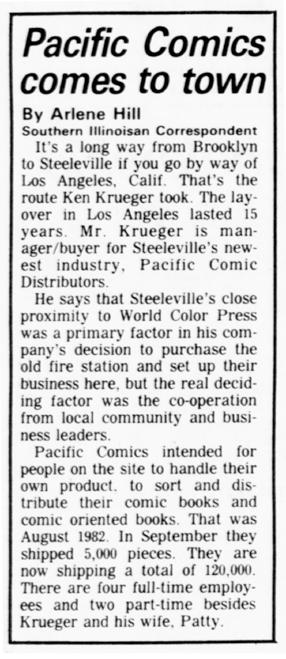
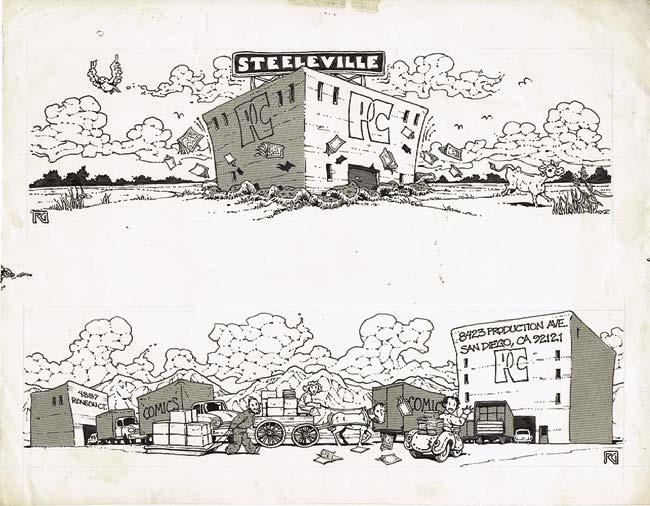
Sanford himself got a job at the Pacific home warehouse around 1983. “I was in nerd nirvana, shuffling
Sanford soon met with the younger Schanes brother. “Bill hired me as a shipping and receiving clerk. My job involved filling orders from back-stock and breaking up shipments of new comics from dozens of publishers once a week. This last endeavor, ‘new-comic day,’ was everyone’s favorite part of the workweek. The center aisle of the warehouse would be filled with rows and rows of brandnew issues, sometimes even overseas and underground comics, all fresh from the presses and smelling of damp ink and newsprint. First we had to fill invoices for San Diego customers, who’d be pounding at the door in a few hours to get their goodies in order to open their shops, but then there was time to read the comics, to catch up on the numerous titles and types of creative offerings coming out from publishers and producers all over the planet.
“On a typical workday, I might be putting together sets of Elfquest magazines for an account in Germany or designing a start-up rack with Mobile Suit Gundam blueprints, Battle of the Planets toys, and Speed Racer Viewmaster reels for a local retail store about to go into Japanimation. Or I could be standing in an assembly line, going through hand-drawn animation cels from the movie, Heavy Metal, and throwing away damaged or chipped cels, stuffing the rest into portfolio packets printed by the Schaneses. (They’d bought a huge stash of
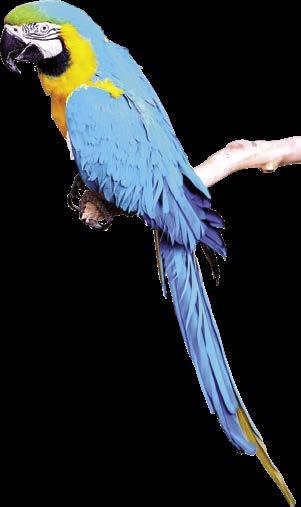
In 1981, my brother, David Scroggy, and I wanted to throw a huge party to celebrate our just released, first new full-color comic book, Captain Victory, by none other than Jack Kirby. We decided to hold the party at the Pacific Comics offices on one of the nights during the San Diego Comic-Con. Our offices were located about a 20-minute drive north from downtown San Diego.

It was a logistical challenge, as we really wanted a big bash, one which would include us hiring a fleet of buses to shuttle business people, artists, retailers, media, printers, family, and friends from downtown to our offices and back (we wanted the buses to run non-stop from 5:00 P.M. to midnight), as we thought it would start slow and pick up speed as the hours passed, and our invited guests finished up their day’s activities at the show. We invited the Who’s Who within our industry, from all aspects of the business, including select loyal fans from our four retail stores, all by invitation only. It was a hot ticket at the time.
We had food catered but, for some reason I can’t recall, we decided to run the bar by ourselves. At that time, the owners of Hi De Ho Comics in Santa Monica, California, were good friends of ours, and had told us they all had been bartenders in the past and that they would volunteer to tend our open bar for the evening. They had supplied us with a very detailed list of name brand types of alcohol, related drink-making requirements, and other details that would be best to use. The bar set-up was positioned in the back, near the loading docks.
Our staff had spent several days spritzing up the offices and kinda cleaning up the two-level warehouse in the back, as the idea was to allow everyone to roam everywhere, including the long rows of inventory, except for the offices, which we purposely kept locked.
The day of the party, our staff was doing split duty, as we still had a huge booth to man during the show hours, plus we had to staff the party (I seem to recall we recruited spouses, best friends, and others we knew).
On the night of the party, everything was set up, and we waited for the first busload of guests to arrive around 5:20 P.M., which is pretty much exactly when the bus
pulled up. As in all parties, the first thing guests head for is the bar, but unfortunately for us, the three guys from Hi De Ho hadn’t shown up yet and, being somewhat short-staffed, I started to take drink orders. Sounds great, except for one huge problem: I don’t drink alcohol, never had, still don’t, and I really didn’t know what was in each drink or what proportions to pour.
So, my first time tending a bar, 60-plus people got off the bus and made their way to our bar, with me behind the makeshift counter. People started to shout out drink requests, rum and Coke — seemed easy, as I had heard of both, and we had both — so I poured 50/50 of each, almost to the top of the cup (seemed right to me), sometimes with ice and sometimes without. The drink orders were being shouted out at a frenzied pace; many of the drinks requests had specific names, which didn’t include the type of alcohol included, so I guessed. I pulled a bottle that I felt sounded like a dark alcohol and poured

That’s basically how Mike Grell described the star of Pacific Comics’ second regular title. The artist-writer told Dewey Cassell, “Starslayer originated as a concept that I pitched to DC Comics. It was intended as a direct counterpart to Warlord. With the Warlord, I had a modern man in a very primitive society and, with Starslayer, I had a primitive man in an ultra-futuristic world. He’s a Celtic chieftain who gets transported basically into the middle of Star Wars, if you will. A shorthand description would be, ‘Braveheart meets Star Wars.’ And it was actually on DC’s schedule when the Implosion hit in the ’70s and it got shelved. ”1
Grell told Jon B. Cooke how he connected with the fledgling company. “I got the opportunity from Pacific Comics to create a project. I was approached by the Schanes brothers, Bill and Steve, who had this concept for a new company that would allow people to create and own their own characters, and thereby sharing a larger portion of the earnings on it. You’d keep the copyright, and things like that, and it was exactly what I was looking for… So Steve and Bill knew about Starslayer, and they said, ‘I understand you have a project, and we’d be very interested in having you come over and do it.’ I was actually the first person to sign with them; Jack Kirby signed a couple of weeks later.” He added with a laugh, “But because Jack was Jack, he’d draw half a book while we were speaking! He delivered his first, and it was printed first, but I was actually the first person to sign.”2
Was he nervous signing with the first truly independent publisher of color comics in the direct market? “I wasn’t the least bit nervous about it,” the artist replied. “This was another step. I was doing the Tarzan comic strip at the time, and The Warlord was continuing… in fact, that was sort of the point where I decided that my energy needed to be a bit more focused, and that was the reason I stepped back from doing the artwork and writing the scripts. I sort of phased myself back, and had a lot more time to devote to what I knew was the coming wave.”3 Starslayer #1 hit shops in late 1981 and sold 140,000 non-returnable copies.
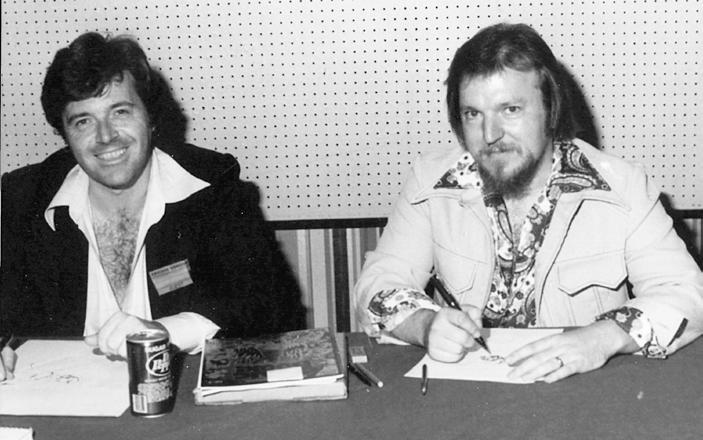
Before 1982 had ended, Grell had completed his first Starslayer story arc with six issues and then, wary of Pacific’s solvency, jumped ship with his creation to join a brand-new independent publisher of color comics — First Comics — where the artist/writer had a run of 28 Starslayer issues, ending that series in 1985. (Bill Schanes bid Grell a friendly adieu in a publisher’s note in Starslayer #6.)
Previous page: Ms. Mystic #1 [Oct. 1982].
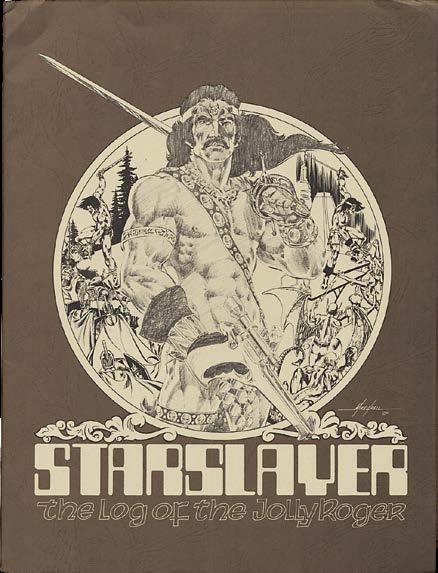 Above: Pacific actually published a Starslayer portfolio first before debuting the comic book series. Below: Neal Adams [left] and Mike Grell, 1977 Chicago Comic-Con.
Above: Pacific actually published a Starslayer portfolio first before debuting the comic book series. Below: Neal Adams [left] and Mike Grell, 1977 Chicago Comic-Con.
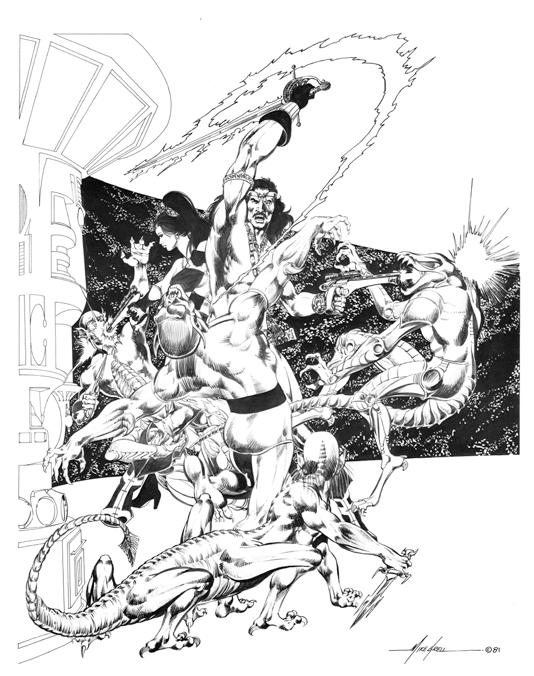
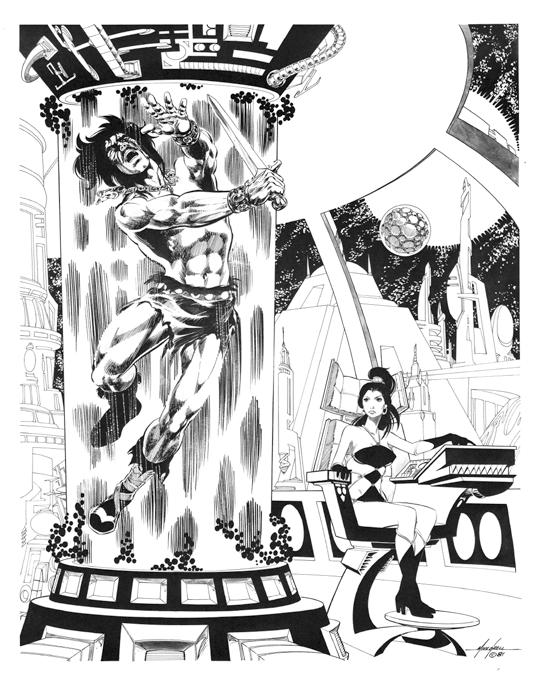
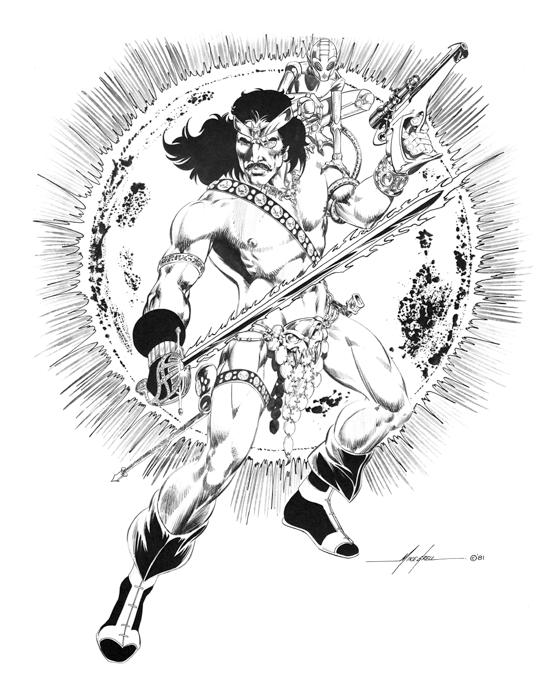
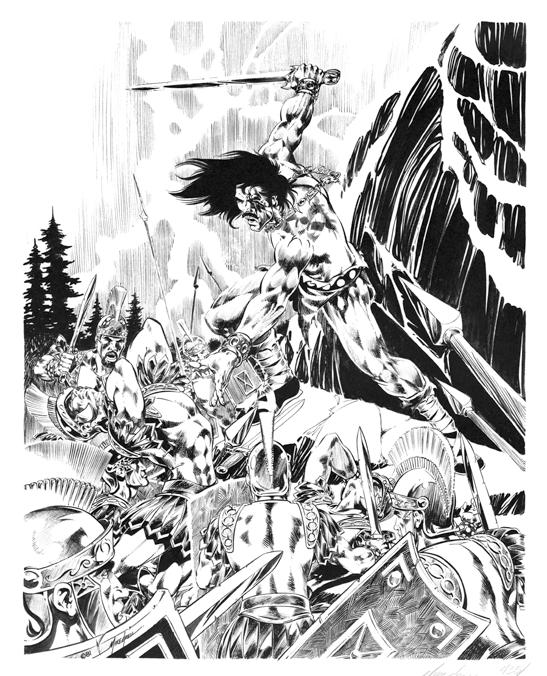
Above: Before confirming with Neal Adams, who was backing away from committing himself to such an ambitious schedule given his advertising workload, Pacific promoted the new title as a bi-monthly series. Alas, over the next two years, only two issues would emerge at the imprint.
Below: Adams introduced Ms. Mystic as one of his “New Heroes,” in a portfolio published in 1979 by Sal Quartuccio.
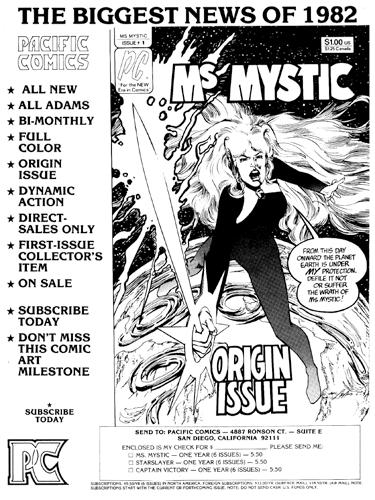
On Dec. 7, 1981, Captain Victory and the Galactic Rangers #3 [Mar. 1982] went on sale and it included a tantalizing four-pager that introduced the comics world to Ms. Mystic, a sensational new character produced by one of comics’ greatest creators. At the time, Neal Adams shared with Gary Groth how the super-heroine went to Pacific, a description that included a young artist who had found work at Continuity Associates, Adams’ art agency. “I’m doing a feature called Ms. Mystic for Pacific that I was originally going to do with Michael Nasser. Mike thought it would be a good idea to do a female character, and I came up with all the concepts behind Ms. Mystic. We decided to do it together, but Mike has since deserted various forms of civilization in favor of living a very, very different life from what most of us live. So, until and unless he comes back and wants to join in, I’m doing Ms. Mystic for Pacific Comics on my own. It’ll be 12 bi-monthly issues. That’s about it. It’s a good character, an interesting character. It’s one of the five characters I created for a portfolio for Sal Quartuccio.
“I didn’t go to Pacific. Pacific came to me. The reason I agreed to do it with Pacific is that, first of all, I don’t intend to be a comic book publisher. I intend to be a comic book — with [emphasis] on book — publisher, in that Continuity will do the graphic novels. Pacific Comics is interested in doing comic books, a field I still wish to be involved in. The reason I went with Pacific is because Pacific was willing to allow me to keep my character, not interfere with any other rights that I would have in the character, not give me a work-for-hire agreement, and pay me a reasonable, though not exorbitant, amount of money for the right to publish it as a comic book. I felt it was a fair deal. In return, my job is to give them a comic book that will sell well and make money for them. It seemed incredibly fair compared to the deals that Marvel and DC offer.”5
The New Heroes portfolio contained a striking plate featuring Ms. Mystic and it included an explicit credit: “Character © 1979 Neal Adams and Mike Nasser,” but Adams would later describe the heroine’s creation as one he came up with completely on his own. In 2015, Adams said, “Pacific was approaching me to do a comic book and I said, basically, ‘Look, I really haven’t got time to do this. Maybe I’ll give it a shot.’ But in the studio, there was a guy named Mike Netzer* who kind of drew like me. Well, he drew exactly like me, or as much as he could. I said, ‘Look, y’know, I can have a guy in my studio work on this and maybe he can do it and I’ll do layouts, blocking out and all the rest of it.’ I was trying to really support Pacific Comics, because I sort of had convinced Jack Kirby to work for them. And also Sergio Aragonés to work for them. I had told them that they not only would pay them, but they would let them keep the rights to their character. They could hardly believe that. At that time, that was actually a phenomenon.
“So, partially the reason I turned the thing into a character was I wanted to promote a company that would do the right thing by the creators. Although that may not have been the first time it was being done, it certainly was the first where you had three well-known, official people out there — myself, Jack Kirby, and Sergio Aragonés — doing characters for more than normal rates, and also that they owned their characters. I was kind of killing about 80 birds with one stone there.”6
The omission of Netzer from the story of Ms. Mystic’s creation was the result of all that had transpired between the two artists over the decades.
* During Michael’s initial extended stay in Israel, he changed his last name of “Nasser” to Hebrew-transliterated “Netzer.”
In 2015, Michael Netzer shared with Shaun Clancy his recollections of the beginnings of Ms. Mystic and his being the catalyst for her creation. “It starts about the time Jenette Kahn became publisher of DC, around late 1976. Vinnie Colletta was the art director and was working with me on the Wonder Woman [#232, June 1977] story that he inked. On one of my visits, he told me that the new publisher would probably like some proposals for a new female super-hero and asked me to come up with a pitch. I was about 20 years old and lacking the type of experience to compete professionally on that level of creating a new character and storyline… but I must have had a lot of ambition because I took the challenge and told Vinnie I’d have an idea for him in a couple weeks.”7
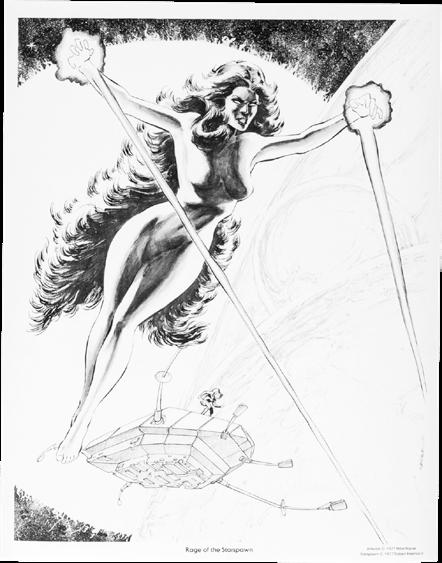
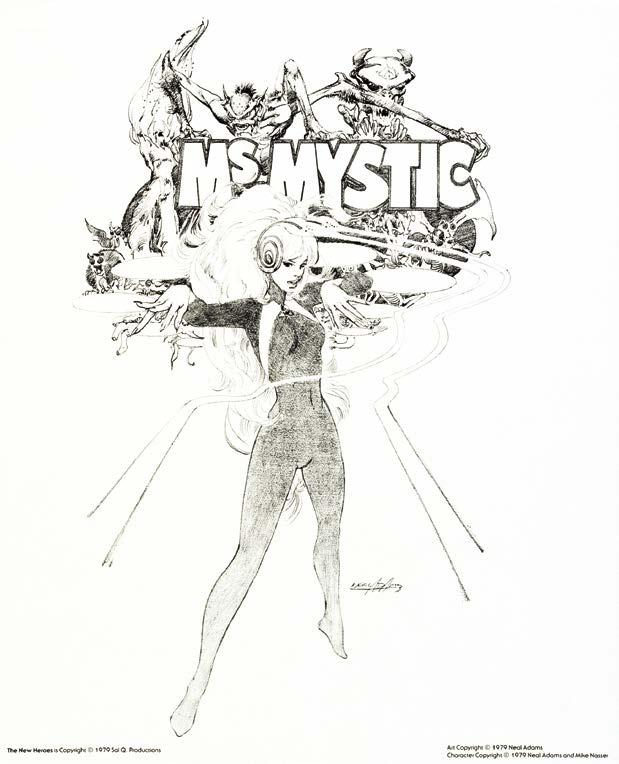
Netzer detailed his conceptualization: “I thought of a character that would be ‘the spirit of the Earth’ type. A girl who grew up with senses and abilities such as making plants grow quickly or making it stop raining if she tried hard enough. She’d later discover that she was a reincarnation of a witch that was burned at the stake in a previous life, because of having these abilities. She’d grow up to understand that her consciousness was one with the consciousness of the Earth and that her ultimate mission, this time around, was to stop civilization from destroying itself and the planet they lived on… I also thought she could be connected to Rama Kushna from ‘Deadman,’ or that she would actually be a physical embodiment of her, for DC continuity, but wasn’t sure how that could work
out yet. It was all happening quickly, within an hour or two, and I hadn’t had enough time to think it through. I had just finished the Starspawn four-piece portfolio for Bob Keenan, one of Sal Quartuccio’s friends, around then. That simple body figure with the body-length hair [left] seemed like a good place to start for a character design, and I began working out a costume that would preserve that look, that I thought had an ethereal feel that expressed the character well. It’s one of the few things that was preserved from my early ideas on it, and still strongly resembles what Ms. Mystic’s look later became through Neal’s embellishment of that design… Neal looked at my sketches and then, to my surprise, suggested that we do it together because I wouldn’t have the experience to
Born: June 1941
Among the most celebrated comic book artists of all time, Adams started his professional career drawing Archie Comics gag pages. He soon earned his own syndicated newspaper strip, Ben Casey, which he drew 1962–66, and, before entering the industry, he worked for Johnstone Cushing, an ad agency specializing in comics.

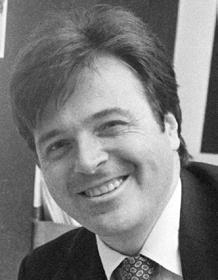
Inset right: Pacific
#1
Look in any comic book price guide under the listings for Starslayer and, as entertaining and collectible as is Mike Grell’s intergalactic saga, you’ll note that #2 [Apr. 1982] and #3 [June 1982] fetch higher prices than the typically coveted first issue. Why is that so? Two words answer the riddle: Dave Stevens.
If Neal Adams’ Ms. Mystic #1 was Pacific Comics’ best-seller, than artist Dave Stevens was the publisher’s greatest creative discovery, and Stevens’ creation of The Rocketeer was sheer serendipity. Kelvin Mao, the director of the full-length feature film documentary on the late artist, Dave Stevens: Drawn to Perfection [2022] — Stevens died at age 52, in 2008 — shared, “Dave... was an extraordinary artist and complicated person who lived life the way he drew: without compromise or yielding to adversity. Everything he produced shined with an unmistakable polish, a feeling of effortlessness that masked his obsessive struggle for perfection.”17
“I came into Pacific Comics right after Jack had done his first issue of Captain Victory,”
Born: Apr. 1954
Before becoming an industry sensation with The Rocketeer, Dave worked as an assistant to Russ Manning on the syndicated Tarzan strip and he worked in the Saturday morning cartoon animation industry. Stevens also had a career as movie storyboard artist before seeing The Rocketeer film released by Disney in 1991.
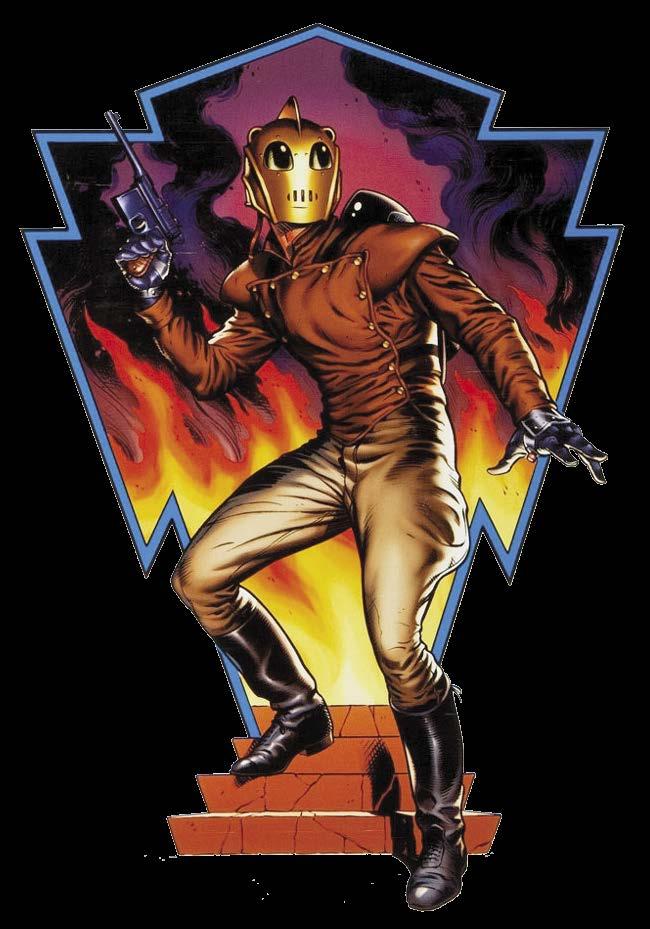
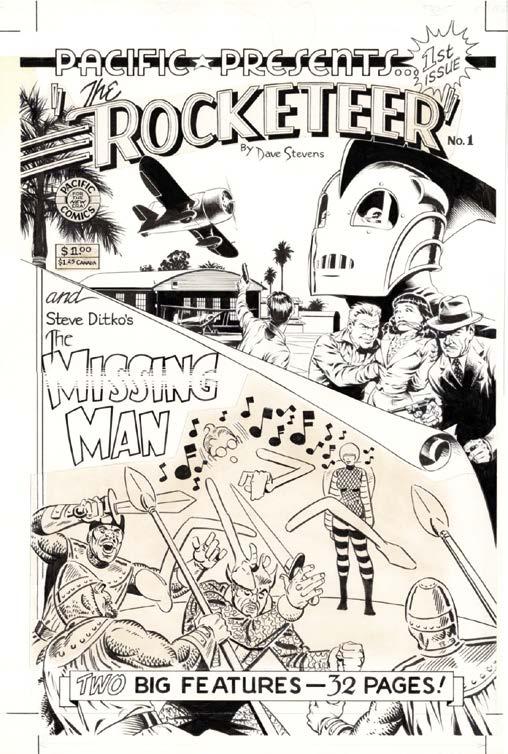
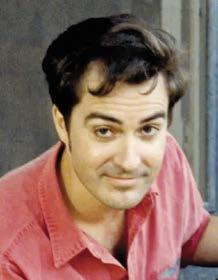
Stevens told Jon B. Cooke, “and Mike Grell had done his first issue of Starslayer The only reason I was even approached was because Grell’s second issue was shy a few pages and they had to fill those pages with something, and they knew that I drew.”18 And, boy howdy, could that man draw!
Stevens explained he knew the Schanes brothers from their comics shop days. “I was a customer when I lived in San Diego, five years earlier,” he said. “So, at the San Diego Comic-Con in 1981, they made the offer: ‘Do whatever you want, but we need two installments of six pages.’ So I said I’d see what I could come up with and went home and started
kicking around some ideas.”19
The conversation, he said, was casual. “I think they were trying to decide how best to fill that spot and I was around, so either Steve or Bill mentioned it to me. I really didn’t regard it as anything important at the time; just ‘filler’ material… the Schaneses just told me to bring them something and left it entirely up to me. So, I came up with a promo drawing (which was also used as the first back cover), and wrote it around that image.”20
Stevens added, “In the first issue of Starslayer, they ran a full-page ad: ‘Coming next issue,’ so, by the time the character appeared, it had already gotten some buzz and people really responded to it. By the time the second chapter came out, Pacific was getting a lot of calls and the immediate thought was that they had a potential cash cow.”21
David Scroggy recalled the development of a book that could showcase the newcomer in a title he would share with a legendary creator. “We had succeeded in attracting Jack Kirby, Mike Grell, and Neal Adams to our upstart comics line-up,” David said. “Why not Steve Ditko? I reached out to Steve Ditko, calling him and explaining our new approach to publishing, with its creator-ownership
and the other benefits. To my elation, he was interested. We wasted no time in signing him up, and gave him a free hand to, as I put it, ‘Do the character he had always wanted to.’ We eagerly awaited his first submission.”22
Scroggy continued, “At the same time, we had been looking for a way to get Dave Stevens involved in our books. Dave was a local and we all were familiar with him due to our time together working on Comic-Con. Everybody who ever saw Dave’s work reckoned him to be a major talent — the guy just had it.”
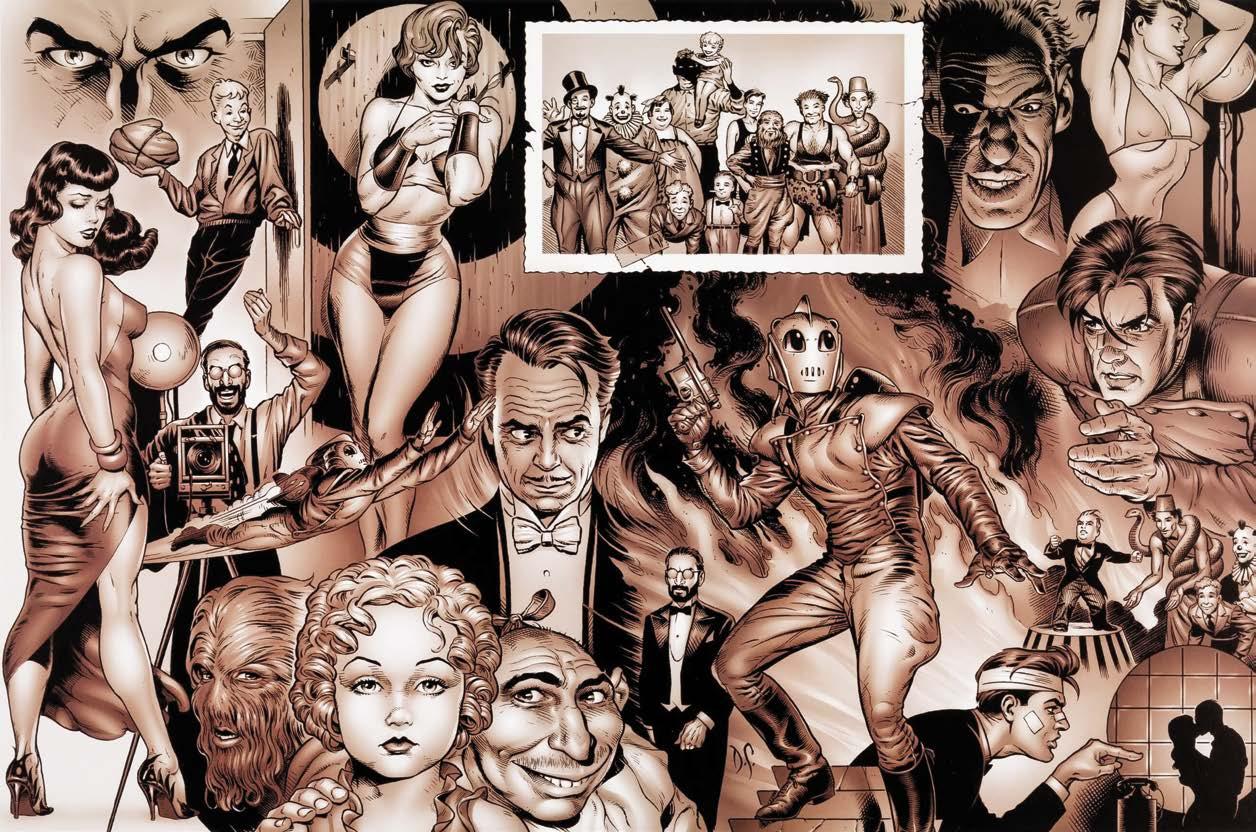
But Scroggy and the Schaneses understood the young artist was meticulous and painstakingly slow. “We didn’t think Dave was able to generate an entire book, however. Dave didn’t either. We realized Ditko’s fame and following among comics fans would mean strong interest in his in-development comic and was certain to enjoy strong support from retailers and fans. It seemed a great idea to have Dave create a back-up strip for Ditko’s lead feature.”23
Scroggy then described the gestation of Stevens’ trademark character. “Dave was a big fan of the old serials, such as Republic’s Commando Cody and His Lost Planet Airmen. The various versions of these 1940s genre stories
featured a character called Rocket Man. Dave was a big fan of this character and thought he could update it effectively. Originally, we considered simply coming forward with the underlying property clearly acknowledged, but were afraid of getting sued. None of us knew anything much about licensing or how to determine intellectual property ownership of this old material. Dave said he would re-work the concept and change it enough that it couldn’t be mistaken for the original property or character. He came back with The Rocketeer. It didn’t take a genius to realize that this was something really special. There was a unanimous green light given, and Dave began to work on it.”24
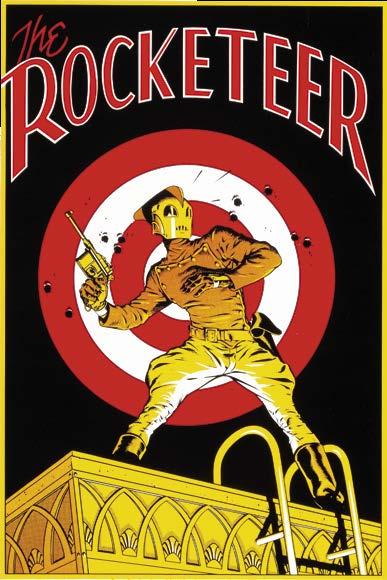
Born: Nov. 1927 Co-creator of Spider-Man, the artist was, with the imminent closure of Charlton Comics, essentially reduced to being without a steady publisher by the time he contributed to Pacific. But, having established a creative partner in Robin Snyder, Ditko was on his way to self-publishing.
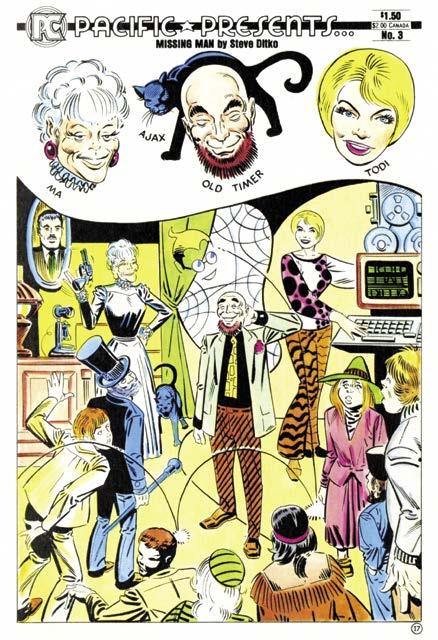
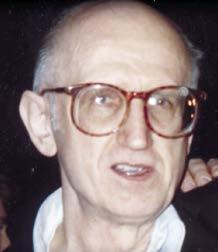
Scroggy explained, “Meanwhile, the Ditko proposal arrived. It was titled ‘Stick Man,’ and was exactly that — a stick figure drawing who leapt about battling crooks with guns. There was no particular plot and any backstory was nonexistent. We were genuinely flummoxed. We didn’t know how to respond. Was Ditko having a joke on us? Did he really mean it? Were we supposed to ‘hang some clothes’ onto the stick figure and flesh it out for him? I very tentatively phoned Mr. Ditko to find out.
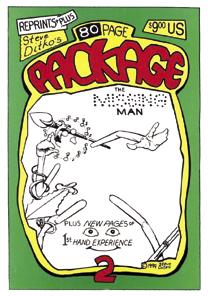
front cover in order to showcase Dave’s art. At the same time, Dave’s legendary perfectionism made the pace of him finishing the pages slower and slower. I found myself as the first in what was to become a long line of editors trying to cajole, demand, or otherwise come up with an accelerated delivery schedule.”25
Above: Steve Ditko reprinted his “Missing Man” work in 1999. Inset right: Apparently this Ditko artwork featuring his “Missing Man” — modified to become an interior page — was intended as the cover of Pacific Presents #3 [Mar. 1984]. Below: Panel from Pacific Presents #1 [Oct. 1982].
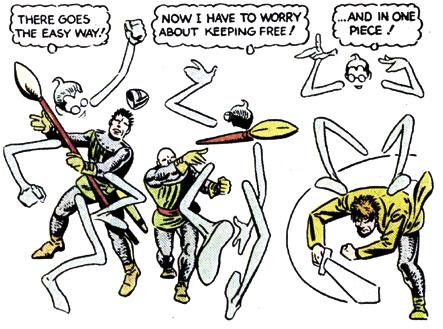
“I soon realized that this was, indeed, what he viewed as a good character and viable proposal. Thinking fast, I remembered a small strip, by underground comix artist R. Crumb, that ran in the margins of one of his comics, titled ‘Stickman.’ It was a throwaway strip, but it did exist. I explained to Ditko that Crumb had been ripped off with his famous ‘Keep on Truckin’’ image and, ever since, had taken pains to copyright his stuff. Ditko accepted this and promised to rework the character. In short order, he sent us a draft of ‘Missing Man.’ There seemed no way to reject it again and still have Ditko do work for us, so we told him to proceed with it.
“When we launched Pacific Presents, we had the interesting situation of the back-up feature being the hit, and the lead feature not going over very well. It was truly a case of the tail wagging the dog. ‘The Rocketeer’ was immediately embraced by readers. It was the first wide exposure of Dave Stevens, and readers were stunned. His characters were classic, not least [due to] The Rocketeer’s girlfriend, Betty, who, as we all know, was a thinly disguised Bettie Page. The marketplace wanted more.
Dave Stevens realized it was his work selling the title, not Ditko’s, and wanted to be featured more prominently. We tried juggling the story placement and splitting the
R. Fiore, in his “Funnybook Roulette” review column in The Comics Journal, noted the imbalance in Pacific Presents. “‘The Rocketeer’ works mostly because of artist/writer Dave Stevens’ excellent feel for ’30s pulp illustration; better than Michael Kaluta’s, actually,” he wrote. “While it suffers a bit from Marvelo-Schmarvelo characterization (main character who becomes a hero to impress his girlfriend, cantankerous employer), the airshow background is novel and the action is fast enough to preclude bothersome activities like thinking. And when’s the last time you saw a new comics artist that reminded you more of Lou Fine than Neal Adams?
“On the other hand, you could miss ‘The Missing Man’ and not miss anything. Steve Ditko’s eccentricities have been losing their charm for some time now, and here it’s descended into self-indulgence. The title character is a page out of Ron Goulart’s ‘Second Banana Superheroes’: Parts of him are, well, missing, so he can beat people up without being grabbed in return. Or something. Beneath the gimmicks is a lot of stale gangster nonsense.”26
Born: Sept. 1937
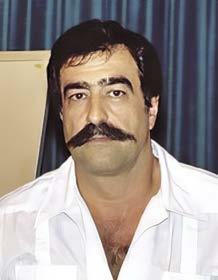
Besides his celebrated stint at MAD magazine, lasting over 50 years, the prolific cartoonist was also a writer for DC Comics from about 1967–77, scribing or plotting stories in numerous genres, including romance, Westerns, and humor. He left DC in a dispute over their workfor-hire policy.
In the 1970s, despite U.S. comics publishers being utterly resistant to the idea of creators owning their own material, Sergio Aragonés, the great MAD magazine “marginal” cartoonist, pondered developing some of his own characters, creations of which he adamantly vowed to retain the rights. “I had already a few stories that I wanted to do, since the ’60s,” he told Jon B. Cooke. “But [to have them published by DC or Marvel] there was no way; in that market, no way. There was no way I was doing comics if I didn’t own them, [like it was] in Europe. So I
had different characters that I wanted to use, but there was no way. There was no publishing house that would share copyright, none. And, for many years, I just drew them with no way to have them published.” The cartoonist had two concepts in particular he was pondering, one being “a Conan parody type of thing.”33
The Spanish-born/Mexican-raised artist continued, “And I liked it a lot, because I thought it could be a very funny character — not Conan, but another barbarian [done with] humor. He was not a satire on Conan; he was just another barbarian, but an idiot. So I talk about doing a comic, but nobody wanted to publish it until 1980-something.”34
Since butting heads with DC editorial in the latter ’70s, Aragonés had paused his longtime association with the publisher, after having ended his humorous one-pagers for the mystery and war books. The reason for the kerfuffle was over creators owning the rights to their own creations. That disrespectful attitude — dismissing any notion of creator’s rights — was the same over at Marvel. “They later changed their mind,” Aragonés told Kim Thompson, “but at that time, there was no way.”35
Aragonés’ friend Mark Evanier told Dan Johnson about his introduction to a completely new character: “Sergio had this beautiful house up in the hills and we were up there one day, and he said, ‘Let me show you something.’ He pulled out these wonderful drawings… and they were all these barbarian characters, and this one in particular named Groo. I asked Sergio, ‘Why Groo?’ He said, ‘I believe that name means nothing anywhere in any language.’”36
Evanier, who had been a one-time assistant to Jack Kirby, continued, “I somehow volunteered to assemble [Destroyer Duck] and Jack Kirby offered to draw the lead story. We needed a back-up series, and the first person I went to was Sergio. I told him about the project, and before I was halfway finished telling him about it, he went to his drawer of series that had not been published and told me, ‘Take anything you want. If it’s not right, I’ll draw something special.’ I said, ‘This is the perfect place to put Groo in, as you’ll own the copyright to it.’ Sergio had one four-page ‘Groo’ story completed, and it was one of only two ‘Groo’ stories I was never involved with because it had no words. I said, ‘Let’s just publish this.’”37
Aragonés remembered to Cooke, “But the first thing we did is, I had done a pantomime story of Groo just to see how he’d work in comic books. And I had that [to show]. And Mark told me that they were doing a comic

“I came of age in the 1950s,” editor/writer/artist Bruce Jones told Jon B. Cooke, “and, even though I sort of missed the EC heyday, I was still very influenced by the non-super-hero comic books (though comics were just one of the things I was reading). I was a voracious reader and most of the stuff I ended up doing for Warren [Publications’ horror comics] — or anybody, really — was based on the short stories and novels I was reading, as well as comic books. The comic books were a factor because I was drawn to the short story-type of horror and sciencefiction kind of comics rather than the super-hero or the
funny animal stuff… It was always the more anthologyoriented short story stuff that I was drawn to. Super-heroes were on the way out and they didn’t come back big until I was already in college, in the ’60s.”48
As an artist deeply influenced by Frank Frazetta and Al Williamson, Jones was among a new generation, one weaned on EC Comics and who came into the profession through comics and science-fiction fandom, a group that included Bernie Wrightson, Jeffrey Jones, and Michael W. Kaluta. Upon determining his strength was as a writer, Bruce scribed among the finest stories for Warren Publications during the ’70s, under brilliant editor Louise Jones (“Weezie,” then wife of Jeffrey Jones) and often teamed with the finest artists working for Weezie, among them Wrightson, Richard Corben, and Russ Heath. When Weezie switched to Marvel, so did Jones, and he worked on her titles, Ka-Zar and Conan the Barbarian.
“I got a call, when I was living in the Midwest, from Steve or Bill Schanes,” Jones told Cooke, “and my intent was to move to California at that point, because I was really sick of the Midwestern winters. I was thinking of going to Los Angeles to investigate the film business and they were in San Diego, so they told me to come out and talk to them because they were interested in my work.
“When I got there, I just fell in love with San Diego — it’s just the greatest town in the world. They made me a very good offer to be with their fledgling publishing company. So, for a time, I was doing work both for them and for Weezie at Marvel. Then Weezie got kicked upstairs and was replaced by an editor I really didn’t get along with that well. So it became very hard to continue with the Ka-Zar and Conan stuff. Plus, the fact I was single-handedly writing
Born: Oct. 1946
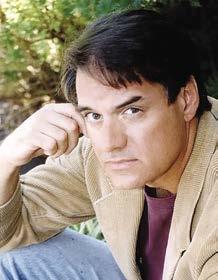
The Missouri native actually first emerged from the fanzine world, where he was recognized as an artist, but it would be his writing for editor
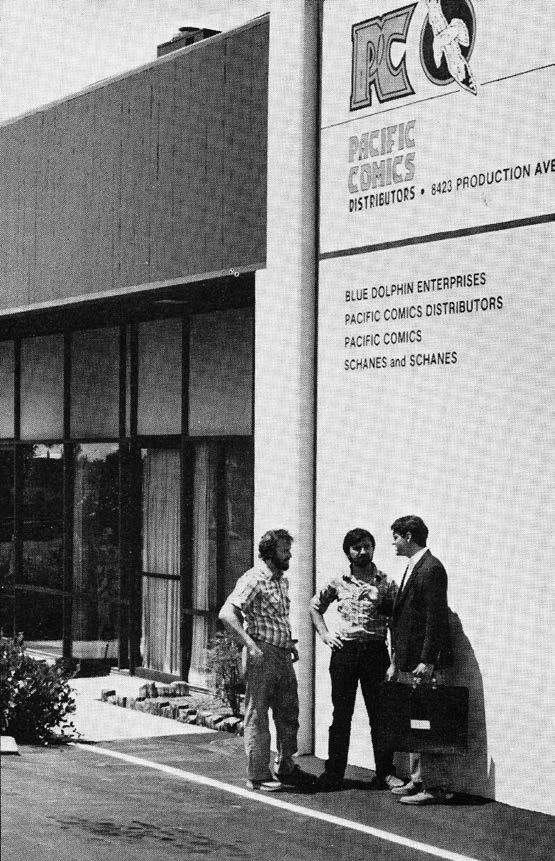
“Weezie” Jones in the Warren horror magazines where he gained renown as one of the best in the field. At Pacific he would also prove a great comics editor and anthologist.
Above: BJA — Bruce Jones Associates — business logo that appeared at the conclusion of the Somerset Holmes [1987] graphic novel. Previous page: Two non-consecutive pages featuring the cartoonist and his writing collaborator, Mark Evanier, from Sergio Aragonés’ Groo Special #1 [Oct. 1984], intended to be a Pacific release, but published by Eclipse. Inset left:

Besides Jones’ often gripping and usually excellent scripts (sometimes illustrated with his own artwork), his anthology titles boasted some of the industry’s finest delineators, including pros Corben, Williamson, Wrightson, Doug Wildey, Mike Ploog, and Frank Brunner, as well as the artist of “Banjo Lessons,” Rand Holmes. Sometimes said artists’ behavior could be less than professional, as David Scroggy recalled. “Bruce Jones and April Campbell Jones were the sole editors and packagers of their titles: Twisted Tales, Alien Worlds, Somerset Holmes, Silverheels, and the sadly short-lived Pathways to Fantasy. Steve Schanes worked with them on certain production issues and color separation, but other than that, the comics were edited 100% by Bruce and April without any editorial contribution from Pacific, other than occasionally suggesting creative talent when Bruce was stuck for an artist and the deadline loomed.
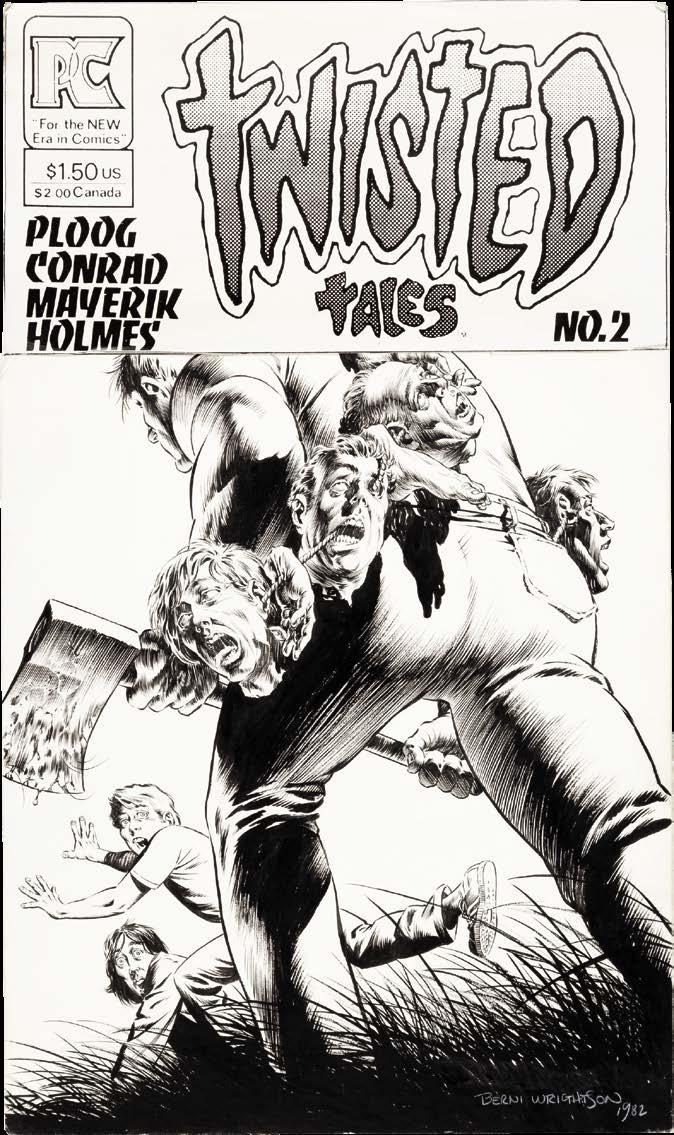
“I did help Bruce once on an editorial matter. Bruce had hired the great underground comix artist Rand Holmes as a contributor. I had worked with Holmes earlier on The Portfolio of Underground Art, so was able to help bring them together initially. After that, it was only Bruce and Rand creating his stories. I forget the specifics of the situation, but Bruce was, as usual, up against his deadline, and urgently needed to contact Rand Holmes, who did not have a telephone. Of course, this was in the pre-internet days, so what might normally be an inconvenience was a crisis. Holmes lived on Lasqueti Island, a tiny place situated off the eastern coast of Vancouver Island, in Canada’s Georgia Strait. It was a very small place, with fewer than 500 inhabitants. Facing an apoplectic Bruce Jones, I came up with an idea. Using directory assistance, I located a general store on Lasqueti Island, and rang them up. I explained to the person who answered that I was calling from San Diego, and urgently needed to reach artist Rand Holmes. Might they possibly know him? ‘Oh yeah… he stops in here,’ was the reply. I said that Bruce Jones was desperately trying to reach him and gave them Bruce’s number to pass along to Rand. They said they would. And they did! Bruce phoned me later that day; he had talked to Rand, and his problem was solved. I don’t know if that qualifies as editorial input to most people, but it does in my book.”57
Bruce Jones also enlisted the work of a number of young artists new to the field, including Dave Stevens, William Wray, Ken Steacy, Thomas Yeates, Scott and Bo
Hampton, and one total newbie who, soon enough, would take the industry by storm. “I still recall being at the Pacific Comics table at an early San Diego Con,” David Scroggy shared, “when this tall, skinny kid with long hair came up with his art portfolio, and showed it to us. After we picked ourselves up from the floor, we asked if we could maybe publish his stuff. Starting tomorrow would be fine. He said, in an ‘aw, shucks’ sort of way, that Marvel had just hired him to do a book called Longshot. Undaunted, Bruce Jones got him to squeeze in a five-pager for Three Dimensional Alien Worlds, which I think was the first widely-seen Art Adams work. The rest, of course, is history.”58
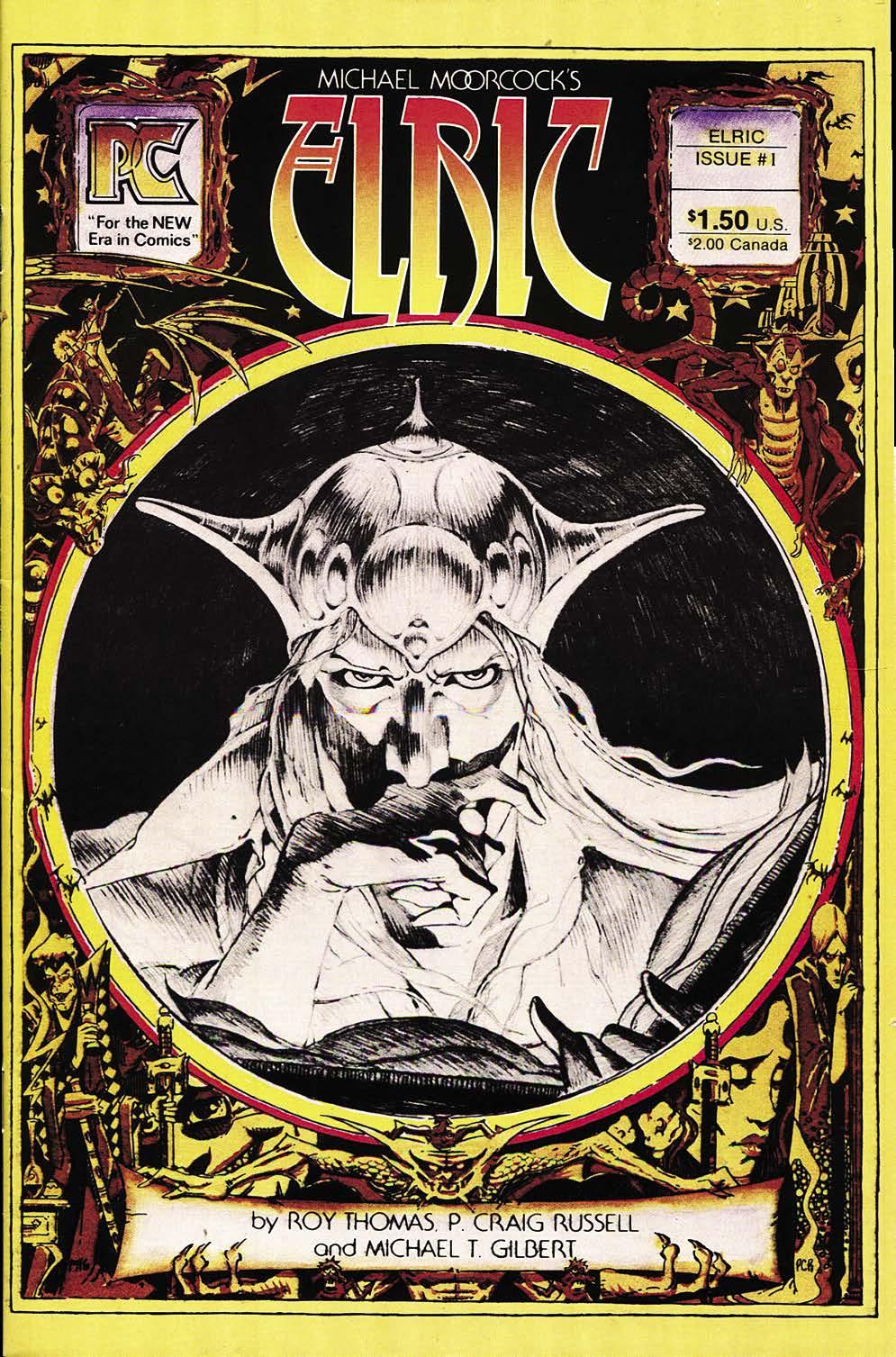
“When the folks at Pacific Comics realized there was room in the market for a company that gave creators ownership of their work* and paid them higher royalties,” observed Steve Duin and Mike Richardson, “Bill Schanes came up with another idea to make Pacific’s books unique: he asked Spartan Printing if they had a better quality of newsprint than DC and Marvel were using.
“In all the years Spartan had been around,” said Pacific’s former editor David Scroggy, “no one had ever asked them that question. They’d only been asked if Spartan had something cheaper.”1
Spartan, of course, was also known as World Color Press, the largest printer of comic books in the industry,2 predominately based in the town of Sparta, Illinois. As The Comics Journal reported, “Ever since the ’60s, most newsstand comics have been printed on 20-lb. newsprint, the lowest grade of paper available from World Color Press. The Sparta-based printer has now, upon request from Pacific Comics, made available a heavier (37-lb.) brand of paper called Mando paper.”
TCJ continued, “This, in fact, is the same stock of paper that was used for comics through the ’60s until, bowing to publishers’ demands for cheaper reproduction, World Color Press began offering the 30-lb. newsprint.”3

Improving the quality of paper stock was to follow a trend, TCJ relayed. “Pacific’s latest move reflects a general inclination of the alternative publishers to avoid the newsprint format. It is generally assumed that the directsales customer is more willing to spend extra money on comics that feature higher production values, and sales on specialty products have for the most part borne this out.”4
“At that time,” Steve Schanes told Jay Allen Sanford, “Marvel and DC were printing on the cheapest low-end newsprint paper with the most economical ink. We started experimenting, partly because we didn’t know any better, with upgraded paper and ink. We went from standard newsprint to Mando book stock, coated covers, and then
something called Baxter paper, perfectly white so that the inks don’t bleed and the colors appear perfectly bright and almost three-dimensional. Our comics ended up looking far superior to what Marvel and DC were putting out.”5
The move to print its entire line on Baxter paper wouldn’t begin until the latter half of 1983 — when, as TCJ reported, “in order to sweeten the inevitable price leap”6 Pacific planned for six titles to switch to all-white (“quality paper” in the company’s marketing parlance) for $1.00 rather than the industry standard of $1.50.
Pacific Comics came roaring into the new year. In September 1982, the local weekly alternative paper, the San Diego Reader, had featured a cover story devoted to the brothers entitled, “Two Boys and Their Comic Books,” and, according to Sanford, Steve Schanes told the Reader, “Pacific had already grossed $3.5 million that year and expected to take in over $5 million in 1983.”7 Sanford also revealed, “The Schaneses were printing about 500,000 comic books in Sparta every month. They employed around 40 people at their San Diego operation alone.”8 Business at 8423 Production Avenue was booming.
Previous page: Elric #1 [April 1983].
Above: In April 1983, Pacific launched its newsletter for dealers, Pacific Premieres, which David Scroggy would produce from start to finish.
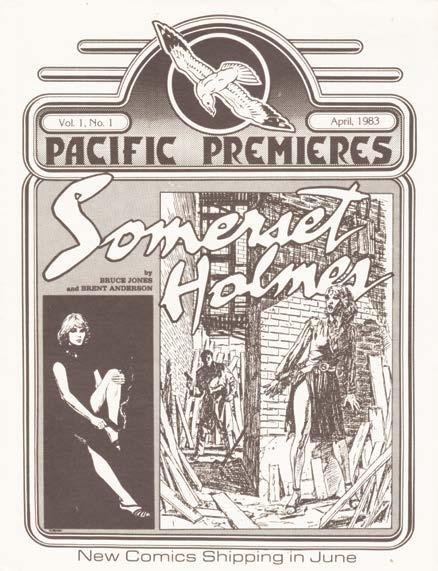
man’s screenplay; nice full-page panel by Kirby from Silver Star #2 [Apr. 1983]; Pacific promo featuring Kirby’s Silver Star; Steve Ditko’s cover art adorns Jack Kirby’s Secret City Saga #1 [May 1993]; the first page of Kirby’s “The Secret City” proposal, which included character designs for the starring heroes; and cover page of Kirby and Steve Sherman’s “Silver Star, Superhero” first draft screenplay, 1975.
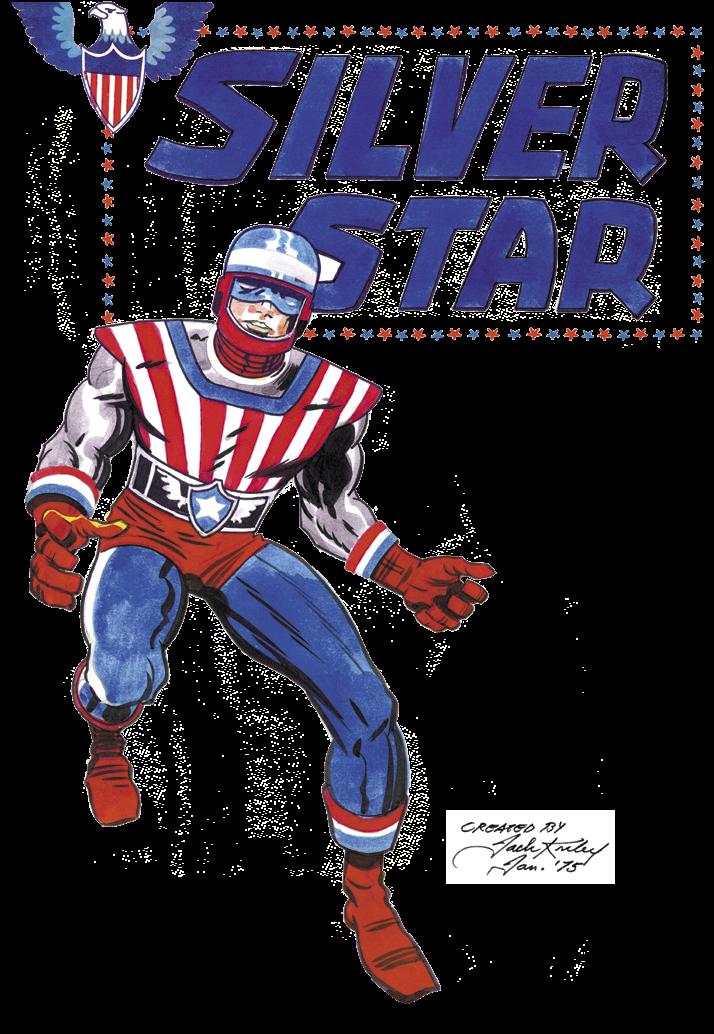
for Pacific to publish, Kirby dusted off a screenplay he had written in 1975 with then assistant Steve Sherman for the Schanes brothers to consider as that second title.
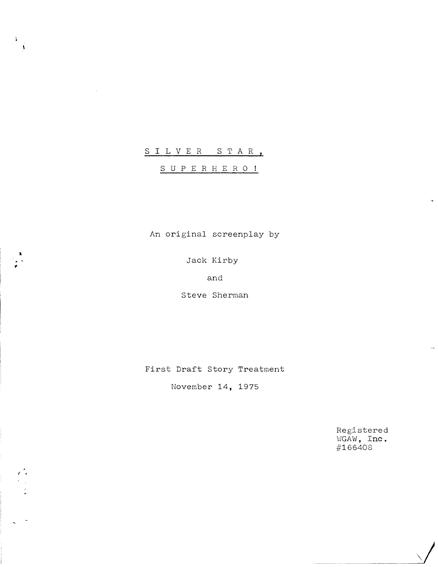
“The concept had started with that single drawing in 1975,” John Morrow explained, “and morphed into a movie screenplay… (complete with Kirby illustrations to help potential investors visualize the idea). Finding no takers for it as a film, the idea languished in the Kirby files until Pacific came a’calling. The original screenplay… provides some extra depth to the characterizations that isn’t evident in the six-issue Pacific Comics series.”10
Morrow continued, “It’s unclear if Kirby intended Silver Star to be an ongoing, open-ended series or if it was meant to last just six issues from the start. He tended
to view all his comics work as having unlimited potential; as long as the audience kept buying it, he’d keep creating new scenarios for the characters. As the series progressed, payments from Pacific Comics reportedly came slower and slower, and the company went into bankruptcy* not long after Kirby’s final issue. But the finale to Kirby’s tale doesn’t seemed to be forced in the final issue, leading me to believe that, at the very least, Kirby intended to wrap-up the tale of Darius Drumm in a six-issue arc before continuing the adventures of Silver Star with another antagonist.”
The Jack Kirby Collector editor explained a singular problem during the series’ run: “Despite Kirby having a full-time job as an animation conceptual artist at the time, the book stuck to a strict bi-monthly schedule throughout its run, with the only glitch being an extra month between issues #4 and #5. This is more than likely attributed to the switch to D. Bruce Berry as inker with #5 (the Disney [animators’] strike ended in mid-series [mid-Oct. 1982], sending Mike Royer back to his day job), rather than Jack’s ability to deliver.”11
Though the relationship with Pacific and Kirby could be strained — de facto business manager Roz Kirby, Jack’s wife, told Gary Groth amid laughter, “We had to call every minute [and ask] ‘Where’s the money? Where’s the check?’ ‘It’s in the mail’… But, they usually finally got it to us”12 — there were plans for even more Kirby projects beyond Captain Victory and the Silver Star limited series. * Technically, Pacific never declared bankruptcy, but went into receivership and had its assets liquidated (albeit the same end).
Born: Nov. 1940
Above: Roy Thomas.

One of the most highly regarded writers in comics, Roy is also a fan historian of the highest caliber as editor of Alter Ego, a magazine that numbers almost 200 issues as of this writing. Also, as Marvel’s editor-in-chief in the 1970s, he helmed the bullpen during one of its most fertile creative periods.

Inset right: Doubtless, Steve Schanes got the notion to approach Mike Friedrich and suggest an Elric series for Pacific because of writer Roy Thomas and artist P. Craig Russell’s 1982 graphic novel adapting Michael Moorcock’s novella, The Dreaming City. Friedrich’s Star*Reach Productions brokered the deal for RT/PCR.
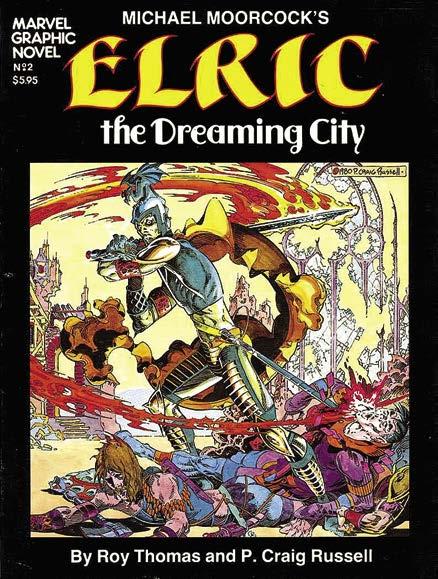
Maybe the earlier publishing model that most resembled Pacific Comics the most was Mike Friedrich’s Star*Reach, a “ground-level” comics company that spawned the same-name black-&-white anthology title (which lasted for 18 issues between 1974–79). Historian Richard J. Arndt explained, Star*Reach — both publishing house and comic book — showed “the industry a new way to sell comics, particularly comics that were neither mainstream (at least, not at the time) nor underground. [Friedrich] demonstrated a method of sales and publication that also gave writers and artists a chunk of the financial action to boot.”16
The Schanes brothers, whose distribution arm had carried Friedrich’s titles, took note of the publisher’s breakthroughs in direct sales and enticements to top talent to contribute to his grand experiment, despite Star*Reach having gone belly-up in 1979. Soon enough, Friedrich would enter the orbit of Pacific Comics.
Born: Oct. 1951
First known for his “Killraven” collaboration with writer Don McGregor, besides his frequent work with superstar author Neil Gaiman, the artist is highly regarded for his magnificent series of opera adaptations rendered in comicbook form. Recent work includes Norse Mythology.
“I went bankrupt as a publisher,” Friedrich shared with Jon B. Cooke, “and I worked at Marvel as a marketing and sales executive for a couple of years, setting up their direct sales department, and I used my salary to pay off my printer, which took me two years, and then I came home [to Berkeley, Calif.]. The first thing I did was enter into a three-month consulting agreement with Pacific Comics, with the option for me to agree to join the company in their publishing efforts.”17
Friedrich and the Schaneses had previously interacted in his role as head of Marvel’s direct sales department. “I had been working with Pacific on behalf of Marvel,” he said. “They were one of my customers, as a distribution company that I dealt with and,
while I was at Marvel, they started their publishing branch, immediately publishing Jack Kirby and then publishing Neal Adams, and it was, like, ‘Okay, something’s going on here.’ So, once I left Marvel, the first phone call I made was to Pacific and they came back with this very generous offer. What I wound up doing was helping them draft a publishing deal in detail that they could use to appeal to the artist community. Pacific publicly released that document as a marketing tool, so a lot of small press people used it as a template for their own deals. So, as an agent five years later, I would get a contract in the mail on behalf of one of my clients and it had been the one I had drafted! So I didn’t have an argument with the terms!”18 For whatever reason, at the end of his 90-day consulting gig, both parties agreed mutually that Friedrich wasn’t a good fit at the company. But one of the Schanes brothers did make a parting suggestion that would retain a sustained connection between them, and it involved a certain stoic albino emperor with a soul-stealing blade.
Mike Friedrich’s connection with the sword-&-sorcery character created by Michael Moorcock stretched back to his Star*Reach days. “I first encountered Elric as a reader while in college… but, in comics, I’m publishing Star*Reach and this incredibly detailed, 20-page, fully finished story by two guys I never heard of before shows up in my mailbox. It was an original Elric story… and I
So was Pacific Comics a significant aspect in the history of comics? “Oh yes,” Friedrich replied. “Short-lived, but an important stepping stone to where the field is today.”
Roy Thomas, who wrote the Elric adaptations at Marvel and Pacific, has few distinct memories regarding the Schanes brothers’ operation, though he did share, “I can’t really remember much, except that Mike Friedrich, as my agent (and controller then of the Elric rights), set it up. I seem to recall having lunch with one with the owners, and they were very enthusiastic, but that’s about it.”31 Along with his artist collaborators on Elric, all three would continue working on the character after the demise of Pacific.
By February 1985, First Comics relaunched the comic-book version of the character in an Elric: Sailor on the Seas of Fate limited series, with Thomas writing and Gilbert contributing layouts and rough pencils, and finishes by George Freeman. The same team produced Elric: The Weird of the White Wolf [First, 1986], and Russell would return 10 years later, only this time as writer and solo artist, for the Topps Elric: Stormbringer [1997] run.

Before Warren Publications would give up the ghost in 1983, Steve Schanes reached out to Jim Warren’s operation to reprint some of its finest horror material. “We had a relationship with them,” Steve recalled. “We dealt with them for several years as distributors. I contacted them about reprinting stories, made a deal, and we picked up the rights to reprint. But I had to make sure they had the right to give us permission. I wrote Bernie [Wrightson] and he wrote me a letter back saying, yes, his understanding was that, when he did work for Warren along with everybody else, that Warren retained all the rights. So that gave me an
We didn’t want to be publishing stuff without creator rights, which was our basic philosophy. We contacted Bernie and we contacted writers. We made sure it’s all kosher.”32
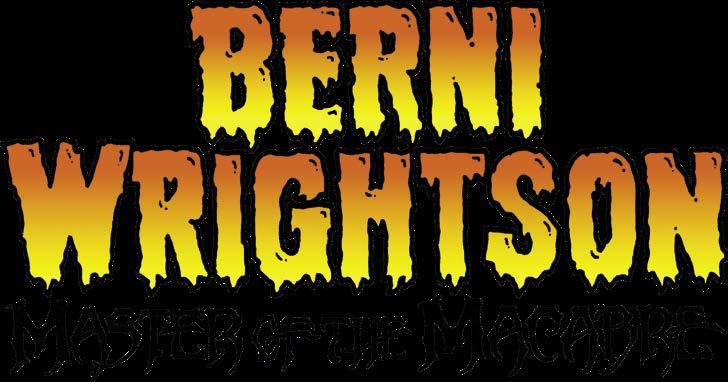
Steve added, “Bernie was just such a nice guy. I got to have meetings several times. He was just delightful.”
Bruce Jones edited the Berni Wrightson: Master of the Macabre series (subsequently picked up by Eclipse), a title singularly devoted to Wrightson’s work, which featured Steve Oliff’s colorized versions of the artist’s Creepy and Eerie black-&-white stories, as well as some of Wrightson’s fanzine material. (The evocative comic book logo was rendered by Wrightson pal William Stout.)
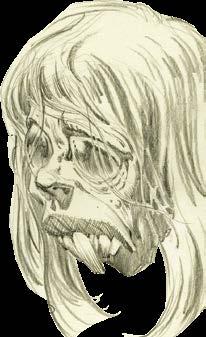
[July
tale.
1974]
Above: Al Williamson’s cover art for his Art of… book, published by Blue Dolphin in Apr. 1983.
Inset right: Page from Scott Shaw!’s Oddball Comics book that was scheduled for Summer 1983 release by Blue Dolphin, but was never published.
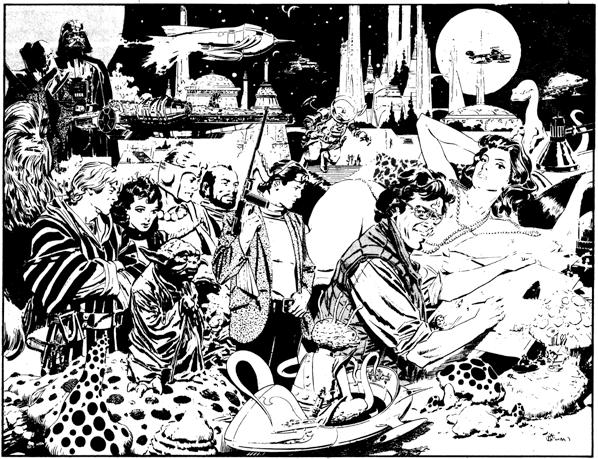
Below: Blue Dolphin’s first release was a history of paperback books translated from Dutch [1982].
Incorporated on Jan. 20, 1981, Blue Dolphin Enterprises was the umbrella corporation name as well as a book publisher imprint established by the Schanes brothers that was distinct from the comics. “I think the Schaneses’ goal with Blue Dolphin,” David Scroggy said, “was to separate the publishing entities in order to better penetrate the bookstore market. We were learning as we went.
“We were offered Piet Schreuders’ Paperbacks, U.S.A. book. This was subtitled ‘A Graphic History 1939–1959,’ and was a compendium of cover art from mass-market paperback books. It was entirely packaged when we received it and is an excellent book. We were presented it by a colorful Dutch fellow named Hugo Van Baren… I don’t think we ever figured out how to obtain an ISBN number, but were proud to have discovered how to get it assigned a Library of Congress catalogue number. The book got a review in Library Journal and we started to receive a ton of purchase order from libraries across the U.S. It was like a Tower of Babel, in that there was no standard system used by libraries to order; they all seemed to have their own diverse fulfillment procedures. We probably lost money filling these orders in a ‘one-potato, two-potato’ fashion, but were happy to do it, envisioning our title on the library shelves. What never did happen, unfortunately, were purchase orders from chain bookstore operations.”33 Blue Dolphin also produced book tie-ins for
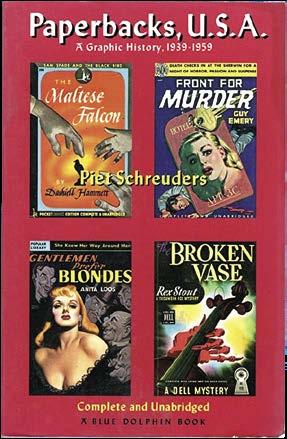
a highly anticipated movie release coming in June 1982. “The Blade Runner titles were something I was very involved with and I still view them as one of my most satisfying accomplishments while at Pacific Comics… This was the early days of licensing — the Ladd Company practically thrust the license on us. I don’t think they could find anyone else. Bill Schanes took their call, and we discussed the tantalizing opportunity. They wanted us to make comic books, but there wasn’t time. We realized that, even if we crashed the boards and jammed out a comic adaptation as fast as we knew how, it would never see print until long after the film’s release. So we wound up with a few projects we could turn around relatively quickly: Blade Runner Sketchbook (which I wrote and edited), The Illustrated Blade Runner (the script and whatever production art we could find), and Blade Runner portfolio (a set of color photos).”
David continued, “I drove up to the Ladd Company offices in my old VW and they opened a closet stacked high with art — mostly Syd Mead’s design sketches for the film.
Veteran comic book master Gray Morrow, who had entered the comics field at the very end of the EC Comics era, bounced around the industry until he found his niche at Warren Publications in the mid-1960s. It was at that publisher where, for about three years or so, Morrow produced groundbreaking, magnificent artwork, from war stories to horror paintings to stunning single-pagers. While he subsequently found work outside the field, in comics, he would drift between companies, though significantly working as a quasi-packager for Archie Publications’ Red Circle line in the early ’70s, as well as for Charlton Comics’ Space: 1999 black-&-white magazine in the mid-’70s.
In a 1983 interview, the artist was asked why he had changed publishers in his career so often. “If you’re referring to comic books,” he replied, “there were always
a lot of frustrations involved. There were a lot of things being discussed over the years that have finally come to pass concerning copyrights and residuals, and all that sort of thing. But they were just talk back then and, as a result, I was often busy working on what I thought was far more rewarding things. For example, for the last five years, I’ve been involved in syndication comic strips for the newspapers.”44
With the advent of improved creators’ rights and freedom afforded by the direct market, Morrow had just the thing for an adventurous publisher: an adult adventure title infused with mythological themes, which he had developed but was awaiting a receptive publisher.
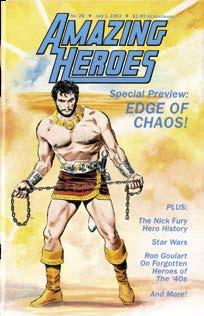
Edge of Chaos was the name of Morrow’s saga of Greek gods and lost Atlantis, a three-issue series he intended to write, pencil, ink, color, and even letter. As the first issue’s editorial by David Scroggy gushed, “There are not many talents who even attempt to carry this load, and even fewer who are able to pull it off. Gray Morrow is one of those rare individuals who brings all the components together into a seamless package that is truly more than the sum of its parts — an adventure that reflects the vision of its creator crystal-clear.”45

Many years later, Scroggy told the author that the comics creator and sometime packager wasn’t solicited by Pacific but rather, “Gray brought it to us, initially through contact with Steve Schanes. The first issue [was] completely done. I didn’t have much contact after that, other than maybe a phone call or two over deadlines with the following issues.”46
From his perspective, the creator saw what transpired a bit differently. “Actually, they chose me,” Morrow told interviewer Kevin McConnell in 1983. “They sent a bunch of material and a copy of their contract to me with a query as to whether or not I would be interested in working on some kind of project with them. I simply followed up on it. As it happened, I had a couple of projects of my own sitting on the shelf, which had been sitting there for a couple of years, and I sort of got them out and dusted them off. I reworked them a little bit and they took it.”47
McConnell then asked Morrow to describe Edge of Chaos. “Oh, I guess the closest you could come is to call it fantasy. It involves pre-deluge Atlantis and events leading up to the cataclysm which wiped the continent out. It involves a man from our own time who is transported back into that time, and the story revolves around him. It also has a great deal of fantasy characters in it from mythology —
project when rollerskating was coming in [as a fad]. We finally got it to print — in other words, nothing happened with the movie for that period of time, and so when we were asked if we had anything lying around, Skateman was lying around. When we asked whether or not we could get permission to print the thing, well, that’s when skating was not only out, but the door had shut.
“So I thought that we had done a fairly good job on the book and I thought that it held together very well, but it wasn’t really intended to be the kind of book that we would think of ourselves as producing. But we did sell 70,000 copies of it and people sort of like it, and people are asking for a second issue… It’s incredible. A lot of people like it. Actually, when you sit down with the book and read it, it holds together. You can take it into the bathroom and read it… Ms. Mystic sold 80,000 copies… In excess of 80,000 copies, through the direct sales market, it’s not bad. For an imitator of Bill Sienkiewicz, I think it did pretty good.”74
Indeed, Skateman was initially a screenplay by filmmaker Ballard, who had put together a promotional package in 1979 to attract investors, which included Neal Adams illustrations based on the movie script. A bookseller website offering the promo packet for sale shared, “While a feature film was never produced, a comic book with art by Adams was published by Pacific Comics in 1983. Originally intended as a tie-in for the film (as mentioned in the booklet), the comic was released as a standalone long after the rollerskating fad had ended, and is still widely considered one of the worst comics ever published. Ballard would continue to try to make Skateman happen, self-publishing three novels, changing the concept to skateboarding, and announcing a casting call for a film (though no film has been made) as recently as 2014.”75 (The website www.skateman.com promoting a new production is live as of this writing.)
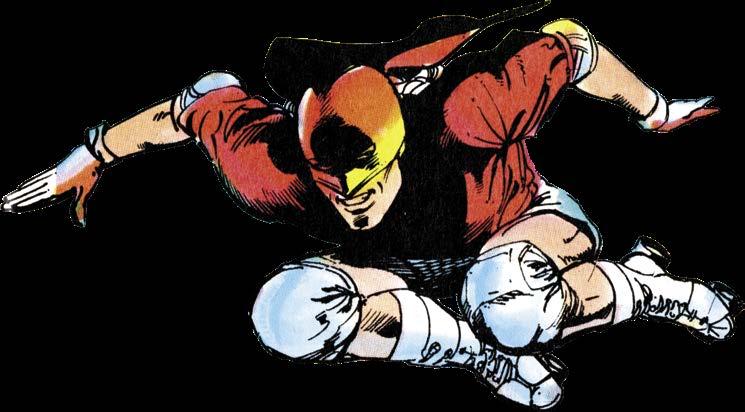
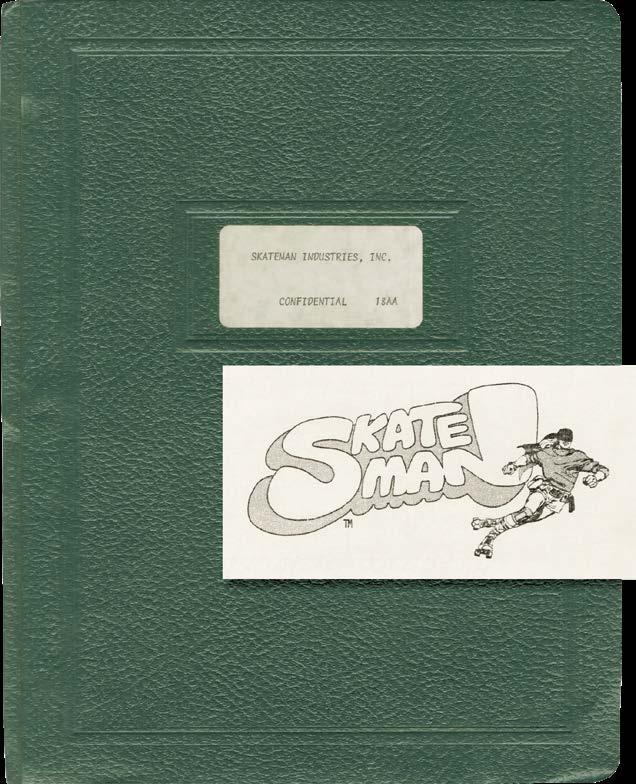
When Adams was told maybe the best criticism received for the comic book was to call it “unfortunate,” he told Peter Stone, “I don’t think Skateman is unfortunate at all. In fact, I think it’s one of the funnier things people criticize in comics. Most of that comic book was not drawn by me, oddly enough. It was drawn by Jim Sherman, a guy who worked in our studio at the time. A nice-looking guy and a decent artist whose style was a little bit like mine. And he did a great job. He got to do more than I did, so it was kind of a Neal Adams/Jim Sherman job.”
On the cusp of Autumn 1983, Pacific Comics released yet another anthology, only this one was devoted to teaming fresh talent with seasoned vets. Vanguard Illustrated #1’s editorial described the scenario: “There is a bumper crop of extremely talented newcomers with an interest in comics these days. As a result of the direct-sales marketing method, comics have become appealing to creative talents once again. The contracts have become fairer and more lucrative. The production values are getting better and better. All of this is acting as a powerful magnet — not
Above: Presentation binder put together by filmmaker John Ballard to lure investors to support his Skateman movie. Neal Adams and his studio produced a comic book story for Ballard, which eventually was repurposed for a Pacific one-shot, Skateman #1 [Nov. 1983].Strange/Silver Dagger (one), The Kree-Skrull War (two), Micronauts Special Edition (five), Moon Knight Special Edition (three), Nick Fury, Agent of Shield (two), Conan the Barbarian (one), Special Edition X-Men (one), and — as apparently one X-Men series being simply not enough — X-Men Classics Starring the X-Men (three).
The head of the other Pacific Comics division saw an existential threat. Reported The Comics Journal, “Ken Kreuger, of Pacific Distribution, says that Marvel’s flood of reprints, in addition to being extremely damaging to the small comic book dealer, is symptomatic of Marvel’s desire to drive out its competition. States Kreuger, ‘A lot of retailers don’t know how to order any more. They haven’t been cutting back on their orders to reflect the additional titles… Marvel really is trying to bleed the buying public out of their last buck, and trying to discourage the smaller publishers. They’ve just about destroyed the small comic book dealer.’”114
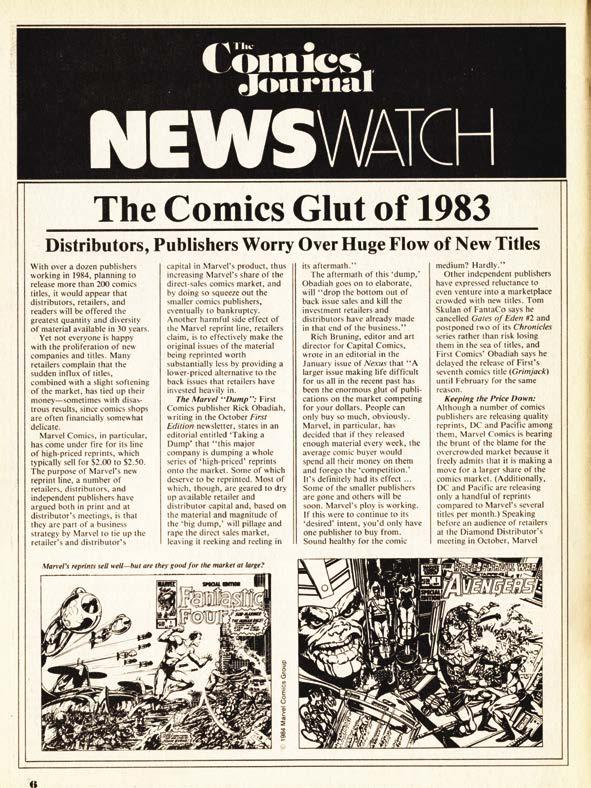
With his imprint less than a year old, First Comics publisher Rick Obadiah took on the leading publisher in the industry with a scathing editorial in the October edition of his house newsletter, First Edition. Under the headline “Taking a Dump,” he railed, “[T]his major company is dumping a whole series of ‘high-priced’ reprints onto the market. Some of which deserved to be reprinted. Most of which, though, are geared to dry up available retailer and distributor capital and, based on the material and magnitude of the ‘big dump,’ will pillage and rape the direct sales market, leaving it reeking and reeling in its aftermath.”113
The ‘major company’ was, naturally, Marvel Comics, which had released nine limited series cover-dated 1982–83 featuring reprint material printed on high quality paper and carrying an expensive pricetag ($2–2.50), including (by one count) Warlock (six issues), Doctor
Over on the publishing side of Pacific, David Scroggy was asked for comment at the time by Diana Schutz regarding the “big dump.” He replied, “Well, I think it’s going to be touch and go. Currently, in the summer, we’re seeing that some of the independents have to make some hard decisions. I feel that Pacific Comics is in perhaps the best position sales-wise of any independent, but we’re all out there struggling very hard to increase our sales and increase our market share. It seems as though the generic name of a Marvel or DC is something that causes dealers to order the books in greater numbers. For example, when we talk to [retailer] Comics & Comix and ask John Barrett how our books are selling, he says that our books are selling great. And when we ask him how many Alien Worlds he ordered for his seven stores, he might say 800, and when we ask him how many [Marvel Super-Heroes] Secret Wars he ordered for his stores, he’ll tell us 16,000, but our books ‘are selling great’!
“A lot of the retailers tend to not stock the independent comics in depth. The reason for that is, in the early days, there came a time of the so-called ‘big dump,’ when dealers found themselves stuck with a lot of independents, because when collectors came in the store, along with their independents were a large number of
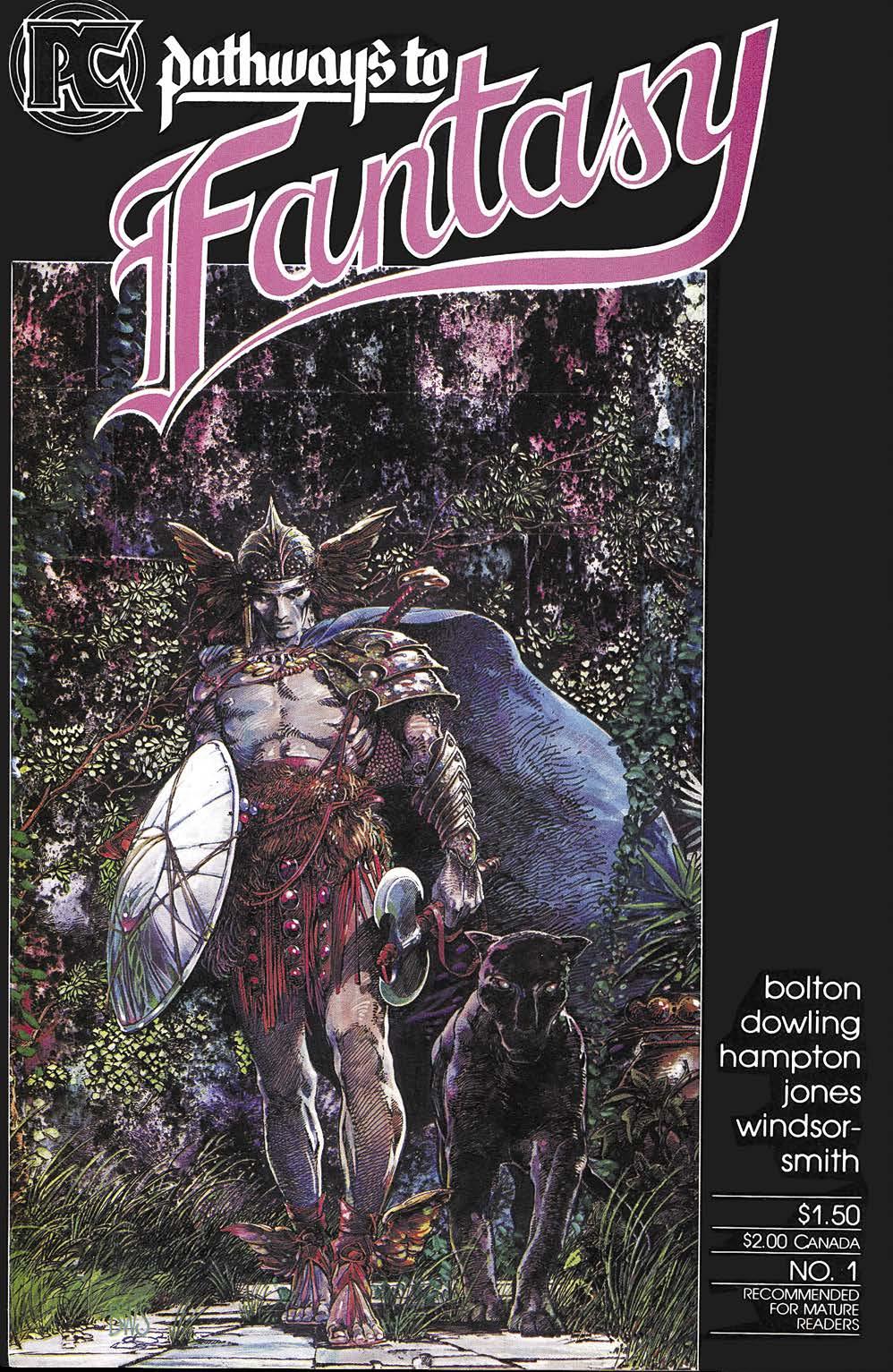
Alan Moore, the genius East Midlands scribe whose arrival in the U.S. would usher in a tsunami of U.K. writers and artists to the American comic book scene, had his utterly groundbreaking “Anatomy Lesson” story [Saga of the Swamp Thing #21, Feb. 1984] go on sale in mid-November 1983, which launched the cult of Moore on this side of the Atlantic. But, back on the British Isles, the writer had already made a notable reputation for excellence in the pages of Warrior, Dez Skinn’s Quality Comics b-&-w monthly, with his “Marvelman” and “V for Vendetta” serials.
Over in Berkeley, California, the innovative proprietor of a burgeoning art agency took notice of Skinn’s cuttingedge mag. “Star*Reach’s Mike Friedrich said he loved Warrior and wanted to be our U.S. agent,” Skinn explained to George Khoury. “I said, ‘Sure.’ Like with the Doctor Who strips that finally made it to Marvel U.S., we’d always planned on making four or five U.S. titles once we had enough material under our belts. The deal had been that, rather than all the creators having to phone the States and go over to sell their strips, Quality — as the originating publisher — would do it for them. We’d take 15% if we sold the stuff, 10% if they cut the deal. After all, if Quality hadn’t forked out in the first place, there’d be nothing to syndicate, so I thought it was a good deal and they all signed up for it.”1
Dummy copies of Marvelman, Pressbutton, V for Vendetta, and others were put together and sent to DC and then to Marvel, after DC blanched at the notion of printing a character called Marvelman. (Skinn said Moore wouldn’t sanction a name change.) Marvel passed — again, because of Marvelman — and then Star*Reach arrived. “The deal that I was putting together,” Skinn told Khoury, “was like the newspaper syndicate deal or films being sold to TV. If you want this one, you gotta take the rest. It’s a package. It’s not a pick and choose. It’s not an à lá carte menu; it’s a set meal. You take the lot or you get nothing. I knew strips like ‘Spiral Past’ — which I put into an anthology alongside ‘Shandor’ and ‘Bojeffries Saga’ — were not the stars of the show, but they deserved to get U.S. syndication. Everybody
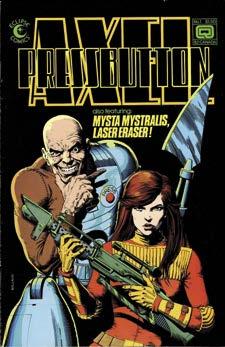
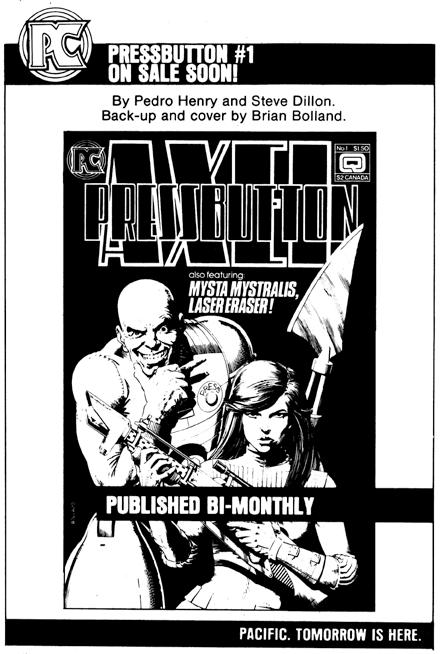
can’t be the star; somebody has to be the warm-up, the back-up. Somebody has to have their name below the titles. So I figured it wouldn’t be fair because, without these guys, we wouldn’t have had an anthology, we would have just had a skinny little pamphlet. These guys deserved syndication, as well. So, the deal was all of them or none. Unfortunately, Marvel and DC couldn’t do Marvelman. So enter Mike Friedrich.
“He said, ‘Let’s try Pacific Comics, they’re expanding. They’ll take them all with no problems.’ But Pacific did the rudest thing of all; they had the audacity to go out of business just as they were about to publish them all. But this was far from instant. Pacific was understandably worried about the name Marvelman…”2
Friedrich recalled, “I have a very clear memory of meeting Dez Skinn in San Francisco. He came to California to meet with me to see whether I would represent the Warrior magazine talent. What he presented me was a document that gave me ‘non-exclusive’ rights to represent
Previous
page: Pathways to Fantasy #1 [July 1984], with art by Barry Windsor-Smith. Above: Pacific house ad promoting Axel Pressbutton #1, which was eventually published by Eclipse (below) in Oct. 1984. Art by Brian Bollandthe strips because he did not have exclusive rights to represent them and I made the mistake — and I’ll say this publicly — of agreeing to go forward, because I ended up with the biggest mess in my agency’s history dealing with Warrior magazine properties. It was mixed. Some of it was very, very positive, and some of it was a mess.”3
The year before Eclipse would publish — in the summer of 1985 — the first issue of Miracleman, David Scroggy explained to Diana Schutz the Pacific Comics plan to reprint the Quality material, starting with Laser Eraser and Pressbutton (which was retitled Axel Pressbutton): “Well, first of all, most of the reprints we’re doing are material that’s never been in color before, and also it’s material that hasn’t been widely available. Obviously, when you’re doing a reprint, you don’t have as much initial outlay, and when you commission a comic book, you’re really putting out a lot of money that you don’t see a return on for quite a long time. So, it’s viable for us as a publisher faced with a kind of softening of sales… Certainly a reprint is less up-front money and can therefore be profitable while selling fewer copies. We have been very concerned about the quality of the material that we reprint, and I do think the things that we’re reprinting are material that is well worth reprinting. Our main two reprint books now will be bi-monthly titles and they will alternate, very much like Twisted Tales and Alien Worlds do. And those will be British material, from Quality Communications, which has appeared in black-&white in Warrior magazine, an import in some specialty shops. One of those titles will be [Axel] Pressbutton, and the other will be Challenger, an anthology title that will carry some regular features and some occasional stories. One of the regular features will be ‘V for Vendetta,’ by Alan Moore and David Lloyd, all newly colored… this is material that reached a very limited audience, and only in black-&-white, so we feel that, while it is a reprint, this one’s almost like a first U.S. printing, you might say.”4
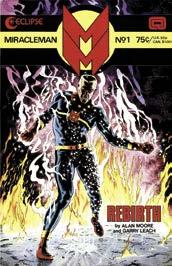
Wholly original — and equally brilliant — material from British creators was to appear in Peter Milligan and Brendan McCarthy’s Strange Days, a continuing title basically spun-off of the mind-blowing “Freakwave” appearances in Vanguard Illustrated.
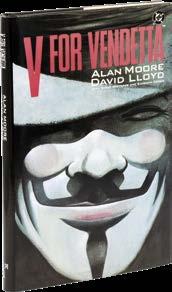
Because Pacific Comics was a business encompassing distribution and publishing, pressures began to strain the company that were unique compared to the other independent imprints. “Distribution is a very marginal business,” Steve Schanes explained in 1988 to Rod Underhill, “maybe working on five to eight percent gross margin. Extremely tough. You have to be very cautious, calculating, you have to really have good controls, and that is a problem all distributors have. Pacific didn’t have good controls to make distribution work. There was a problem with buying too much — Pacific overbought with the assumption that it could sell the inventory. The critical overbuy was during a period [in 1983] called ‘Black September.’ It was when Marvel decided to release a tremendous amount of product, and the marketplace was impacted in a manner that caused the retailers to possibly order less ‘independent’ product.”5
Steve continued, “The retailers and distributors underestimated the impact of the load. What happened was all the other stuff we bought, that we would have ordinarily sold over a period of time, three months to nine months, didn’t turn. We built up massive quantities of inventory. We ended up with way too much inventory and it caused a real bottleneck on the cash-flow.”
Pacific’s main competitor of comparable size was Chicago-based First Comics, which took Marvel Comics to court regarding its over-saturating the marketplace. “Consumers have only a finite amount of money to spend, and retailers in the competitive marketplace must purchase their comic books on a no-return basis; with its monopolistic position, when Marvel is flooding the field, retailers cannot afford to give people a fair chance,” First business manager Richard Felber stated publicly.6
“Marvel Comics historically has taken similar marketflooding actions when faced with the prospect of serious new competition… In November of 1982, when First Comics’ initial publication was released, it would cost the consumer $42.05 to purchase one copy of each Marvel publication released in the competitive market during the month. In November 1983, one year later, it would cost the same consumer $109.35 to purchase one copy of each Marvel publication.
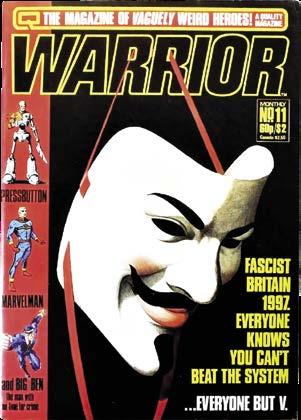
“Many of these additional Marvel publications were hastily put-together reprints and collections of inventory material, some of which was added retroactively. Retailers who were ordering items to be released in September
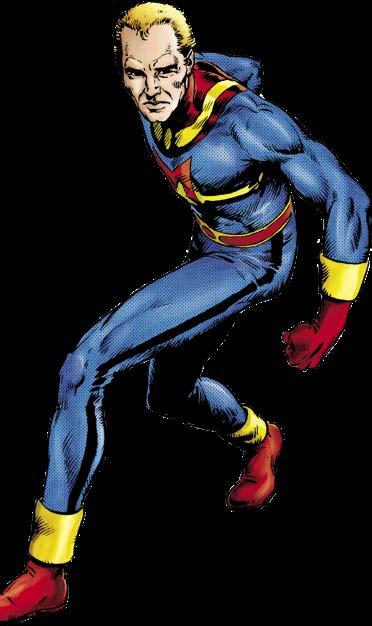
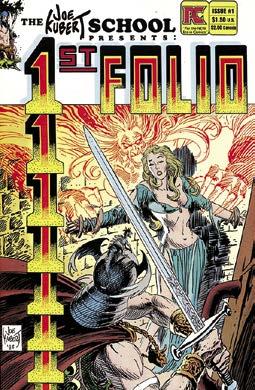
It’s remarkable how few comics titles and individual issues Pacific Comics produced in its short lifespan and, inversely, how many of those comic books were topnotch in content and production. And, to prove the point, below is an overview of the entire Pacific line — all 36 titles and 109 individual issues — including a couple of publications outside comics proper, but of interest to comics fans nonetheless. Featured here are listings of all of the comics work in the titles themselves, though space restrictions forced us to omit pin-ups and editorial content details. Story titles are featured in boldface type accompanied by the number of pages therein. The creators are listed below story titles with the following bracketed designations:
Joe
[s] = Scripter
[p] = Penciler
[i] = Inker
[l] = Letterer
[c] = Colorist
[d] = Dialoguer
[p-a] = Plot assist or Co-plotter
[story] = Original author of work being adapted
We must acknowledge our sincere gratitude to the Grand Comics Database and its army of volunteers whose accomplishments make that website — www.comics.org — the invaluable reference resource it is for comics lovers and scholars everywhere. Referring to the GCD helped confirm and clarify the findings here.
Michael Chen [s/p]
“Physical Barriers” 2
Andy Kubert [s/p/i]
“The Trophy” 2
Andy Kubert [s/p/i]
“Dragon” 6
Andy Kubert [s/p/i]?
“Things That Go Bump in the Night” 3
Andy Kubert [s/p/i]
“Criminal Operations” 7
Rex Lindsey [s/p/i]
Andy Kubert [l]
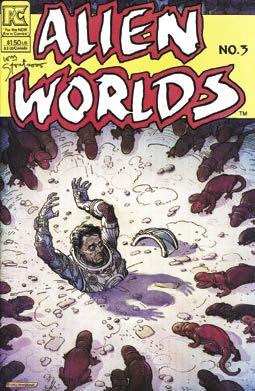
“Tate’s Hell” 3
Brad K. Joyce [s/p/i]
Additional editorial and in-house ad pages
#1 Dec. 1982
Joe Chiodo cover
“The Few and the Far” 6
Bruce Jones [s] Al Williamson [p/i]
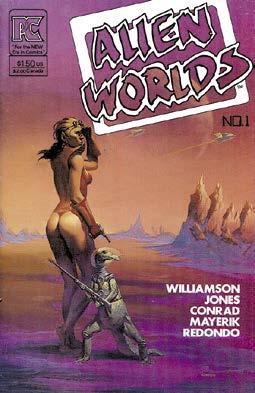
Ed King [l] Steve Oliff [c]
“Domain” 7
Bruce Jones [s] Val Mayerik [p/i]
Carrie McCarthy [l] S. Oliff [c]
“Head of the Class” 7
Bruce Jones [s] Nestor Redondo [p/i] Redondo Studios [l]
Steve Oliff [c]
“Talk to Tedi” 10
Bruce Jones [s] Tim Conrad [p/i]
Ed King [l] Steve Oliff [c]
Additional editorial and in-house ad pages
#2 May 1983
Dave Stevens cover “Aurora” 15
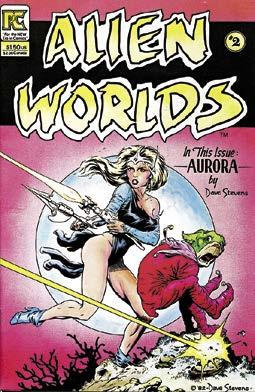
B. Jones [s] Dave Stevens [p/i]
Carrie McCarthy [l] S. Oliff [c]
“Vicious Circle” 8
Ken Steacy [s/p/i/c/l]
“A Mind of Her Own” 5
Bruce Jones [s/p/i]
C. McCarthy [l] Steve Oliff [c]
Additional editorial and in-house ad pages
William Stout cover
“The Inheritors” 10
B. Jones [s] Scott Hampton [p/i]
Carrie McCarthy [l]
“Pi in the Sky” 8
B. Jones [s] Ken Steacy [p/i/c]
Carrie McCarthy [l]
“Dark Passage”
Bruce Jones [s] Thomas Yeates [p/i] C. McCarthy [l]
Steve Oliff [c]
15
Additional editorial and in-house ad pages
John Bolton cover “Lip Service”
10
Bruce Jones [s] John Bolton [p/i]
C. McCarthy [l] Joe Chiodo [c]
“Game Wars”
B. Jones [s] Ken Steacy [p/i/c]
“Plastic”
B. Jones [s]
Adolpho Buylla [p/i]
Ed King [l] Joe Chiodo [c]
“Wasteland”
Bruce Jones [s] Tom Yeates [p/i]
Tim Harkins [l] Joe Chiodo [c]
Additional editorial and in-house ad pages
Dave Stevens cover
“Princess Pam” 4
Bruce Jones [s/p] D. Stevens [i]
C. McCarthy [l] Joe Chiodo [c]
“Girl of My Schemes” 10
B. Jones [s] Bo Hampton [p/i]
C. McCarthy [l] Joe Chiodo [c]
“One Day in Ohio” 6
B. Jones [s]
Ken Steacy [p/i/c]
Carrie McCarthy [l]
“Deep Secrets” 2
Bruce Jones [s]
Jeffrey Jones [p/i/l/c]
“Land of Fire” 8
Bruce Jones [s]
Al Williamson, Angelo Torres, Roy Krenkel [p]
Al Williamson, Angelo Torres, Frank Frazetta [i]
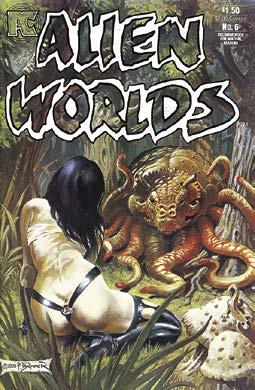
C. McCarthy [l]
Joe Chiodo [c]
Note: Art reprinted from witzend #1 [1966], but Bruce Jones rewrote the story.
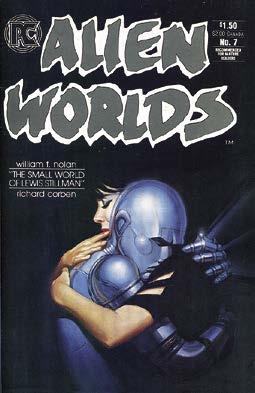
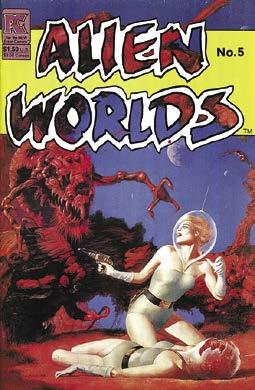
Additional editorial and in-house ad pages
3
Mike Mignola [i]
Carrie McCarthy [l]
Joe Chiodo [c]
Additional editorial and in-house ad pages
#7 Apr. 1984
Joe Chiodo cover
McWilliams, John Prentice, Ray Bradbury, Fred Fredericks, Roy Krenkel, Angelo Torres, Gray Morrow, George Lucas, and Archie Goodwin, and afterword by George Evans. Also includes the following reprints:
“The Hunter”
8 Reprint from Two Gun Kid #25 [Sept. 1955]
“The Little Earth”
10 Reprint from Blast-Off #1 [Oct. 1965]. (Pencils by Reed Crandall.)
“The Vicious Space Pirates”
12 Reprint from Danger is Our Business #1 [July 1953]. (Inks by Frank Frazetta.)
“The Lizard”
16 Reprint from Mystery Tales #51 [Mar. 1957]. (Inks by Ralph Mayo.)
“Robbie”
2 Reprint from Fantasy Illustrated #2 [Spr. 1964]. (Unsold comic strip.)
“Star Wars” 3
Unused Star Wars comic strips.
8
8
“The Small World of Lewis Stillman” 10
William F. Nolan [story]
Richard Corben [adaptation/p/i/c]
“Small Change”
Bruce Jones [s]
Brent Anderson [p/i]
“Secret Agent Corrigan” 33 Reprints of newspaper strip.
“The Gunslinger” 4 Reprint from Kid Slade, Gunfighter #7 [May 1957].
2
“It All Fits” 10
Bruce Jones [s] Gray Morrow [p/i]
“Ride the Blue Bus”
6 B. Jones [s] George Pérez [p/i]
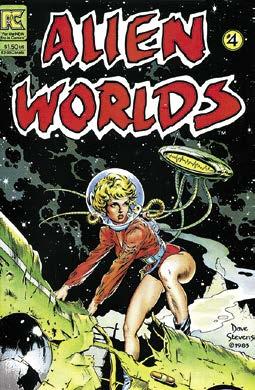
Additional editorial and in-house ad pages
IF YOU ENJOYED THIS PREVIEW, CLICK THE LINK BELOW TO ORDER THIS BOOK!
 by STEPHAN FRIEDT with JON B. COOKE
by STEPHAN FRIEDT with JON B. COOKE
Frank Brunner cover
“Planet Prefect”
Bruce Jones [s]
Jim Sullivan [p]
Arthur Suydam [i]
Carrie McCarthy [l] Steve Oliff [c]
“The Test”
Bruce Jones [s] Val Mayerik, Roy Krenkel [p/i]
David Cody Weiss [l]
Joe Chiodo [c]
“Pride of the Fleet” 19
B. Jones [s]
Frank Brunner [p]
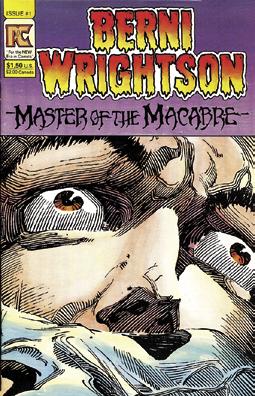
Author STEPHAN FRIEDT shares the story of the meteoric rise of the Schanes brothers’ California-based imprint PACIFIC COMICS, which published such legends as JACK KIRBY, SERGIO ARAGONÉS, STEVE DITKO, NEAL ADAMS, MIKE GRELL, BERNIE WRIGHTSON, and DAVE STEVENS
Apr. 1983
Al Williamson wraparound cover Trade paperback about the artist includes introduction by William Stout, interviews with or testimonials by Williamson, Bill Gaines, Frank Frazetta, Al
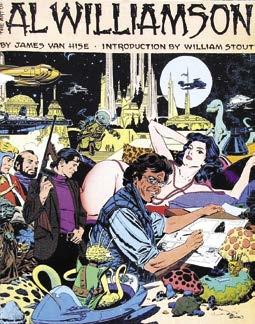
#1
Bernie Wrightson cover “The Muck Monster” 7 Bernie Wrightson [s/p/i]
Steve Oliff [c] (Colorized reprint from Eerie #68 [Sept. 1975])
“The Pepper Lake Monster” 10 Bernie Wrightson [s/p/i]
From its groundbreaking 1981 arrival in the fledgling direct sales market, to a catastrophic, precipitous fall after only four years, THE PACIFIC COMICS COMPANION reveals the inside saga, as told to Friedt by BILL AND STEVE SCHANES, DAVID SCROGGY, and many of the creators themselves. It also focuses on the titles and the amazing array of characters they introduced to an unsuspecting world, including THE ROCKETEER, CAPTAIN VICTORY, MS. MYSTIC, GROO THE WANDERER, STARSLAYER, and many more. Written with the editorial assist of Eisner Award-winning historian JON B. COOKE, this retrospective is the most comprehensive study of an essential publisher in the development of the creator’s rights movement. Main cover illustration by DAVE STEVENS SHIPS NOVEMBER 2023!
Steve Oliff [c] (Colorized reprint from Eerie #58 [July 1974])
(160-page COLOR SOFTCOVER) $29.95 • (Digital Edition) $15.99 • ISBN: 978-1-60549-121-9
https://twomorrows.com/index.php?main_page=product_info&cPath=95_94&products_id=1759
“Edgar Allan Poe’s The Black Cat”12 Edgar Allan Poe [story]